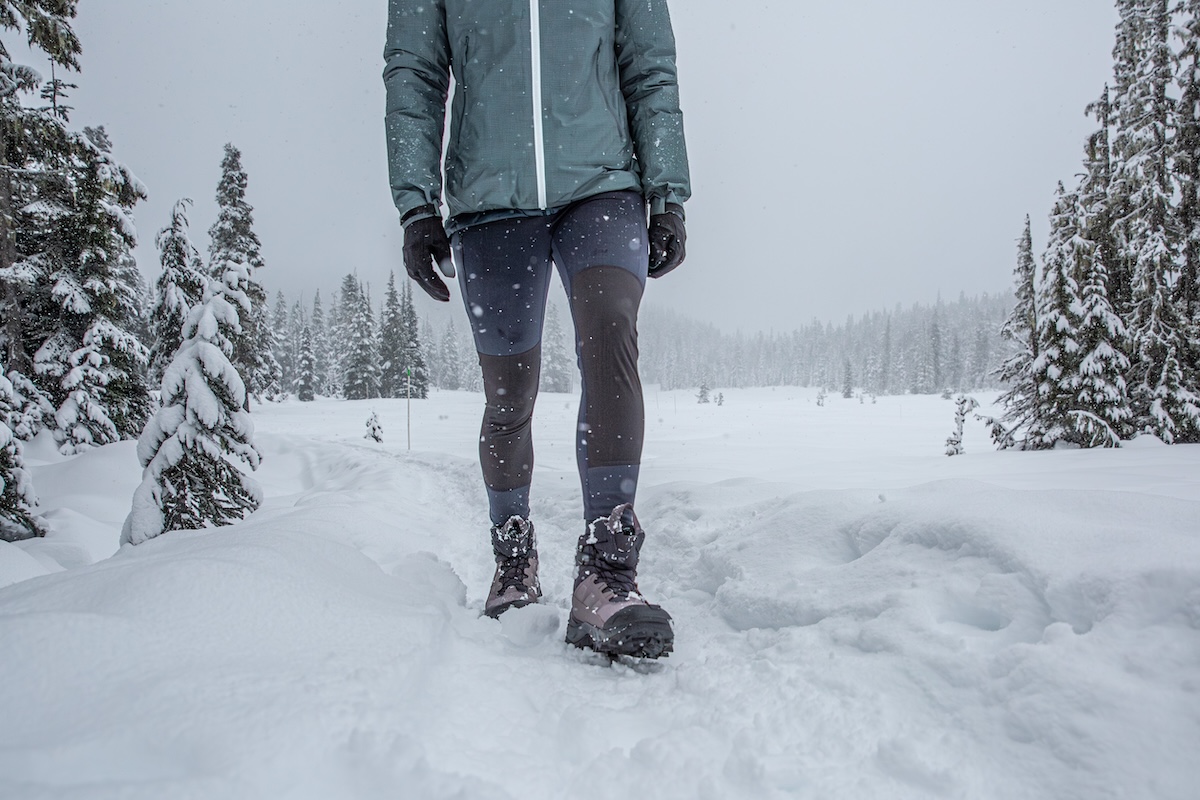
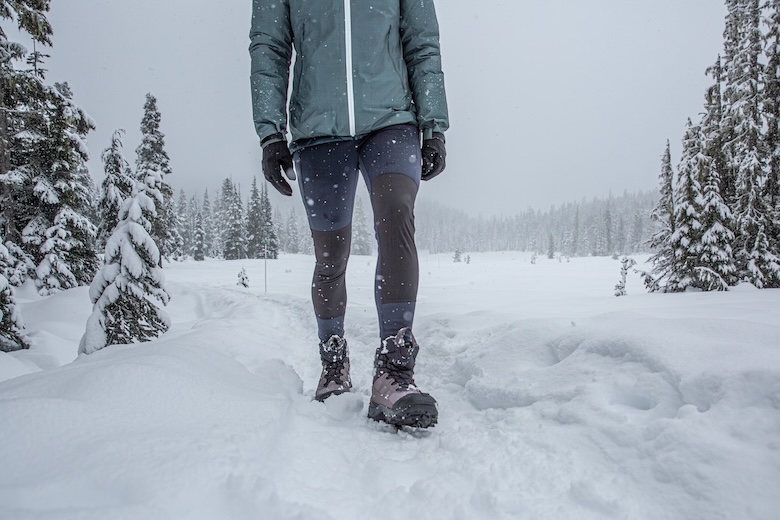
Switchback Travel (Jason Hummel)
Winter boots remain a timeless, charming, and vital piece of gear. From classic Sorels to light and modern waterproof designs, they aim to keep your feet protected and warm from snow and frigid temperatures. Whether you live in a cold and snowy climate, like to hit the trail in the winter, or want to keep your feet warm for après ski, it's likely you'll need a winter boot. Below, we break down the best winter boots of 2025, which include options for work, hiking, and extreme cold, though our favorite overall boots are The North Face Chilkat V 400 for men and the Ugg Adirondack Boot XXV for women (and both are available for either gender). For more information, check out specifics about our testing process, as well as our comprehensive comparison tables and buying advice. Of note: This article includes picks for both men and women, but we’ve also written a dedicated round-up on the best women’s winter boots.
Editor’s note: We updated this review on October 2, 2025, to update all the boots in our lineup to their most current versions and prices. We also added additional insight and imagery from continued testing.
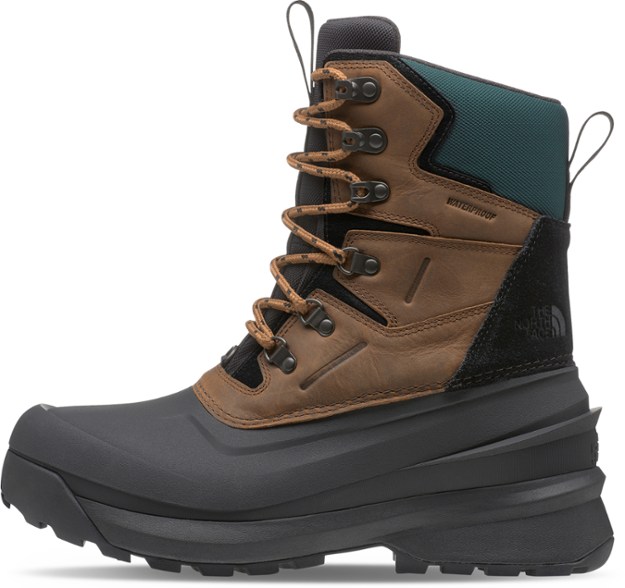 Category: Casual/work
Category: Casual/work
Insulation: 400g Heatseeker Eco
Shaft height: 8 in.
What we like: A good-looking, protective, and grippy all-rounder.
What we don’t: Not-quite premium quality; too stiff and bulky for long hikes.
Many winter boots are specialized for warmth, mobility, or even style, but The North Face’s Chilkat V 400 is a true all-rounder. This full-grain leather design features a molded TPU shell, waterproof membrane for sealing out moisture, and TNF’s Surface Control sole for truly impressive traction in cold conditions and on slippery ground. In terms of insulation, you get 400-gram Heatseeker Eco, which offers a generous amount of warmth for sustained time in the cold. Finally, the Chilkat V 400 tacks on some nice performance features, including D-ring gaiter attachments and a heel clip to keep your snowshoes or winter traction devices in place (we've also found the heel piece makes it easier to take them off). It all adds up to a well-balanced design that’s equally at home shoveling the driveway and running errands as it is hiking on slick trails.
However, as with any jack-of-all-trades design, the Chilkat has a few trade-offs. The thick 400g insulation will be overkill for mild days or dry conditions, and its added bulk (along with hefty TPU shell) does not lend itself to great freedom of movement. If the majority of your use is on hiking trails—especially steep ones—we recommend a lighter and more flexible design like the Merrell Thermo Chill below. And while the Chilkat is serviceable for every-so-often use, those who experience long and harsh winters might want to opt for a more premium boot, such as the Sorel Caribou, Baffin Impact, or Muck Boot (all below). But for around-town wear and light winter walks in less-than-extreme conditions, the Chilkat offers a hard-to-beat combination of style, durability, and performance.
Read more: The North Face Chilkat V 400 review
See the Men's TNF Chilkat V 400 See the Women's TNF Chilkat V 400
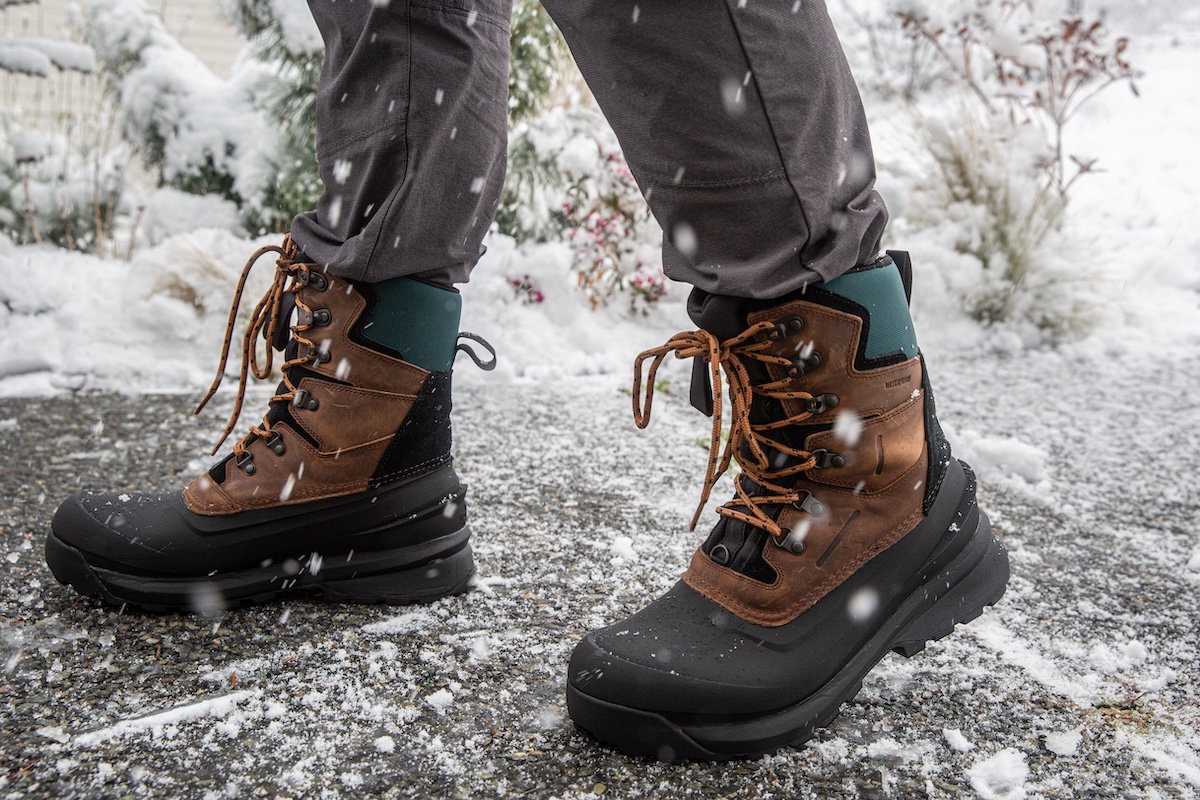

Category: Casual
Insulation: 3M Xerogel
Shaft height: 8 in. (9.5 in. unfolded)
What we like: Well-made, versatile foldable cuff design, very warm and cozy.
What we don’t: Pricey and can be too warm for mild conditions.
Ugg may not be the brand you think of when it comes to a sturdy and reliable winter boot, but the Adirondack continues to be a favorite of ours, year after year. It provides excellent protection from snow, slush, and rain, with premium leather and suede, a waterproof membrane, rubber reinforcements on the heel and toe, and a plush wool liner. Not only is the wool interior super warm, but it also helps to keep snow from sneaking inside and getting your socks wet. We also love the versatile cuff: leave it up for a taller, more traditional and functional boot, or roll it down for a more casual look when the temperatures are milder. One of our editors has been wearing the Adirondack III for at least five years, and it still looks practically brand new. We expect the same level of performance from this new 25th anniversary edition, which we'll report back on as the snow starts to fall.
The men's version of this boot was previously called the Butte, but the Butte and the women's Adirondack have now been merged, resulting in the Adirondack XXV. The XXV features updated materials, including upcycled wool and a sugarcane EVA midsole, as well as a higher tongue for added protection. This has always been a seriously warm boot—Ugg claims it's comfortable down to -32ºC, or -25.6ºF, which we haven't tested out, but when paired with a thick pair of wool socks, we've definitely overheated on milder days. If your feet run warm or you tend to be active in your winter boots, the Adirondack could be overkill. We've also noticed that the interior is so plush that it tends to grab onto socks if their material isn't very smooth. Finally, if you think you might need more protection, the Adirondack XXV is also available in a tall version for $75 more. All told, if you want style, comfort, and excellent traction and weatherproofing, the Adirondack is a staple in our winter kit for a reason.
Read more: Ugg Adirondack III review (prior version)
See the Women's Ugg Adirondack Boot XXV See the Men's Ugg Adirondack Boot XXV
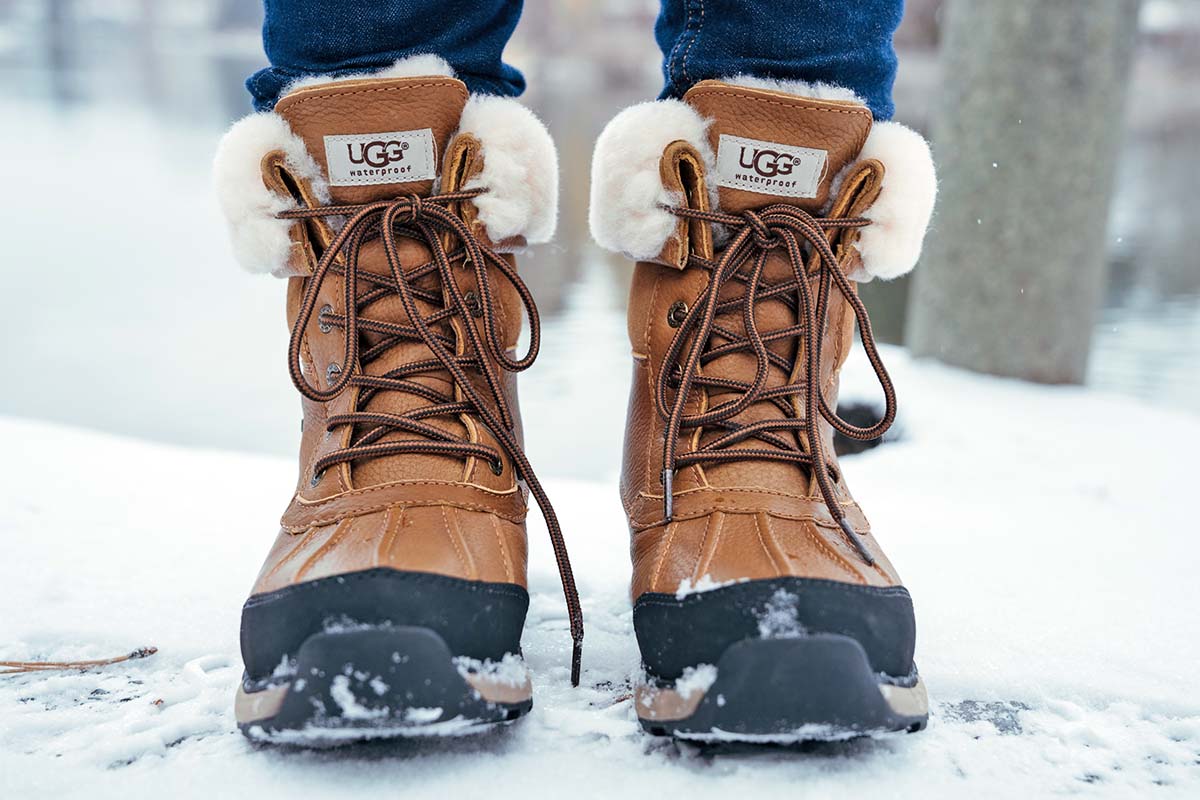
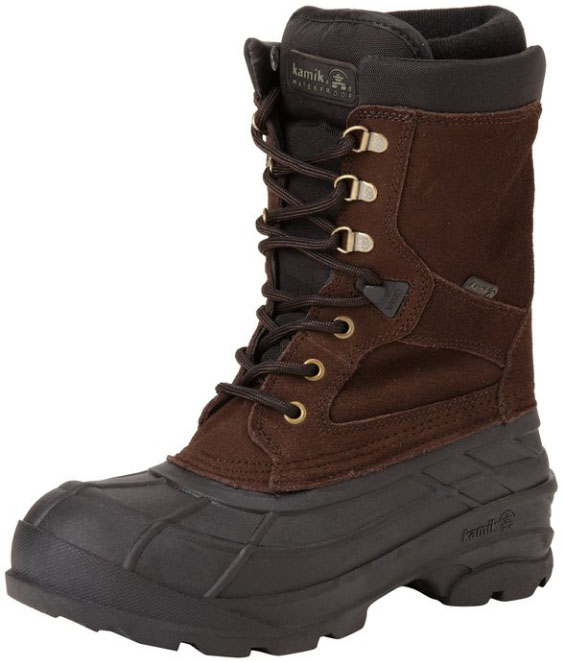 Category: Casual/work
Category: Casual/work
Insulation: 145g Heat-MX synthetic
Shaft height: 10 in.
What we like: Reasonably warm and comfortable at a great price.
What we don’t: Loose fit and some cheaper materials.
Kamik’s Nation Plus doesn’t stand out in any particular category, but it checks all the right boxes for a quality budget option. The boot features a traditional construction with a sturdy leather upper and thick rubber, providing waterproof protection for the feet and toes. Insulation comes from the removable liner, which includes 145g of synthetic material, and the tall cut does a good job of protecting your feet and lower calves. Pair this boot with some thick socks, and the Nation Plus will keep you comfortable while walking or shoveling snow in temperatures well below freezing.
What do you give up at the Nation Plus’s value price? The materials aren’t up to the standards you’ll find on more expensive models, and we’ve experienced occasional long-term durability issues. Further, the removable liner gives the Nation Plus a loose feel that you can’t cinch down as snugly as the TNF Chilkat V 400 above or Merrell Thermo Chill below. That said, this isn’t a dealbreaker for everyday tasks and short walks, and the $100 price tag is hard to beat if you plan to stick to casual wear or outdoor chores.
Read more: Kamik Nation Plus review
See the Men's Kamik Nation Plus
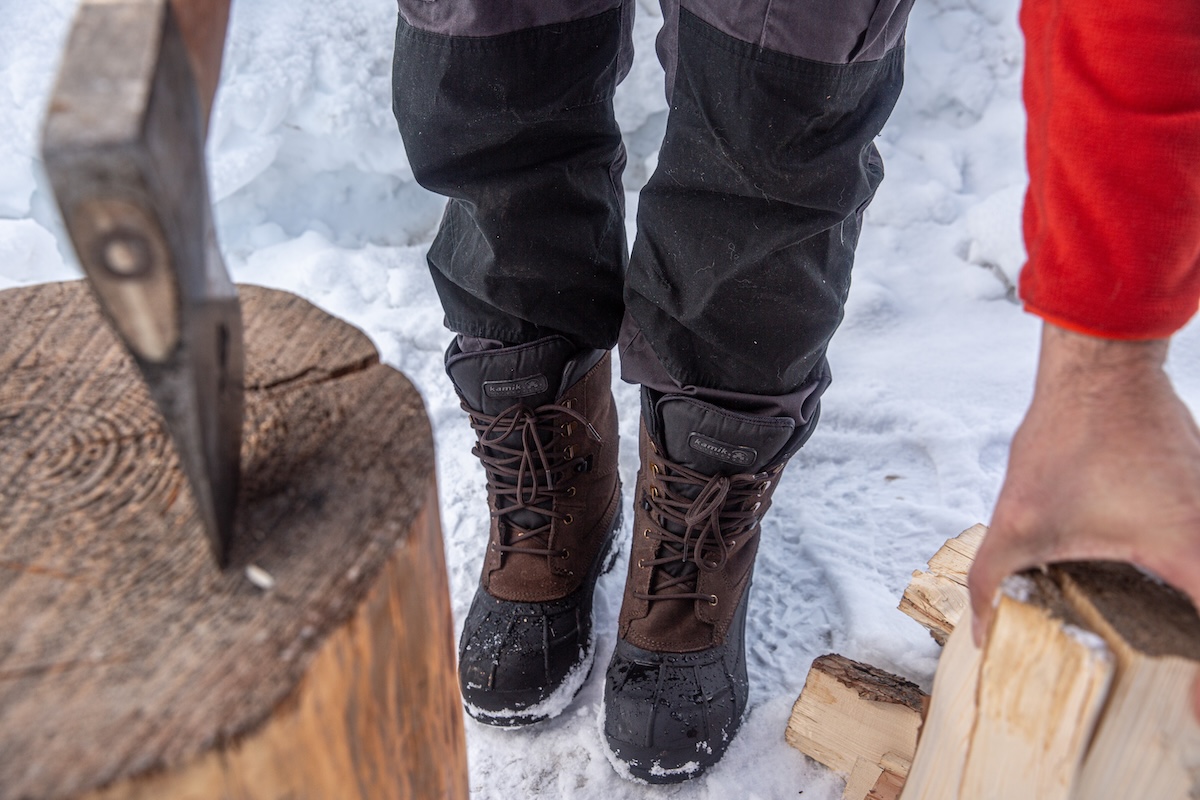

Category: Casual
Insulation: 145g Heat-MX synthetic
Shaft height: 11.75 in.
What we like: A functional and cute winter boot at a great price.
What we don’t: Lacking in structure and middling warmth.
Besides the stellar price point, the women's Kamik Momentum 3 has a lot to offer. Tough rubber around the entire lower portion meets a well-designed waterproof nylon upper with sealed seams, which is rare at this budget price. The generous 11.75-inch shaft provides excellent clearance in deeper snow drifts, and the cozy faux-fur collar also helps keep moisture out of the boot, as well as add some style points. Comfort is also high for the Momentum, and the bungee lacing system makes on-and-off quick and easy. Overall, we love this affordable boot for casual day-to-day winter excursions in milder temperatures.
Kamik claims the Momentum 3 will keep you warm down to -40 degrees F. While we haven't experienced temperatures this low in testing, we find the claim pretty outrageous. The soles of the boots are thin, and the construction doesn't include a separate liner like the men's Nation Plus above. That said, the rest of the boot does a great job insulating—if you're moving around and active, the thin sole shouldn't present much of a problem. We had just hoped this cute boot could be a viable option for hanging out après ski, but our feet got cold when we weren't moving. And while we like the bungee laces, they don't allow you to dial in fit quite as nicely as with the Ugg Adirondack above or Oboz Bridger below. Still, we love the versatility and style of the Momentum, and it's undoubtedly a great value choice.
Read more: Kamik Momentum 3 review
See the Kamik Momentum 3
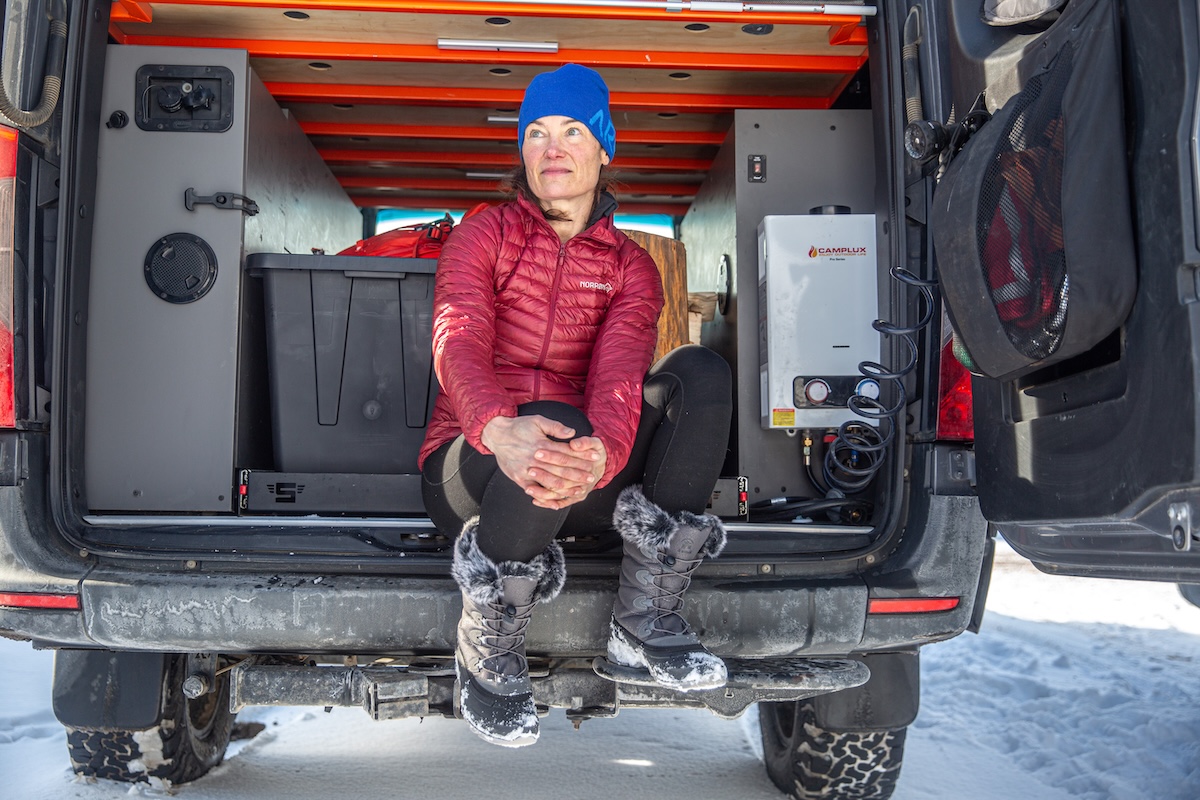
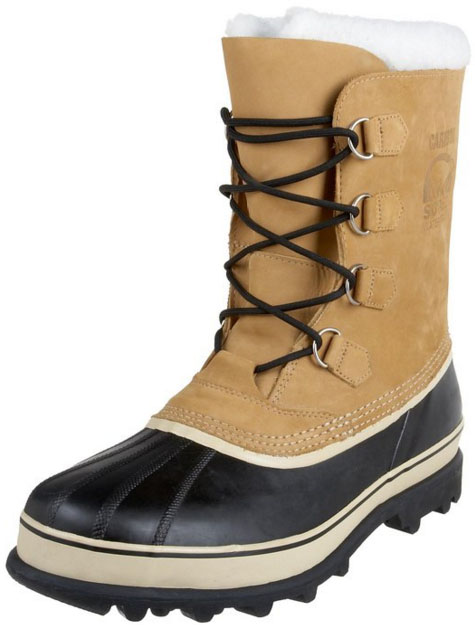 Category: Casual/work
Category: Casual/work
Insulation: 9mm felt
Shaft height: 10 in. (men's), 9 in. (women's)
What we like: Timeless look and cozy interior.
What we don’t: Big and heavy.
It doesn’t get much more classic than this. The Caribou from Sorel has seemingly been around forever, and we love the mix of comfort, style, and performance. This is a very warm boot with a 9-millimeter felt liner, cozy Sherpa pile cuff, stout leather upper, and wraparound rubber lower that provides a nice boost of assurance when walking through slushy puddles. Most manufacturers nowadays turn to synthetic insulation to reduce bulk, but the Caribou’s throwback felt interior is notably warm and adds soft cushioning around your feet. The liner is also removable, which is a nice feature to expedite the drying process should the boot get wet in deep snow.
The Caribou is an undisputed classic for all-around winter use, and the tall shaft offers a lot more protection than a mid-height design like the Merrell Thermo Chill below. However, the Sorel falls short when it comes to walking long distances: the heavy build will feel much more cumbersome than a lighter and sleeker design, and some might even find it too much boot for around-town errands like driving and quick trips to the grocery store. Finally, at $225, the Caribou costs over twice as much as our budget picks above, although you get what you pay for with Sorel’s attention to quality. All gripes aside, the Caribou is a versatile pick for everything from outdoor chores to après ski, and it’s hard to argue with its iconic and timeless style.
Read more: Sorel Caribou review (men's version)
See the Men's Sorel Caribou See the Women's Sorel Caribou
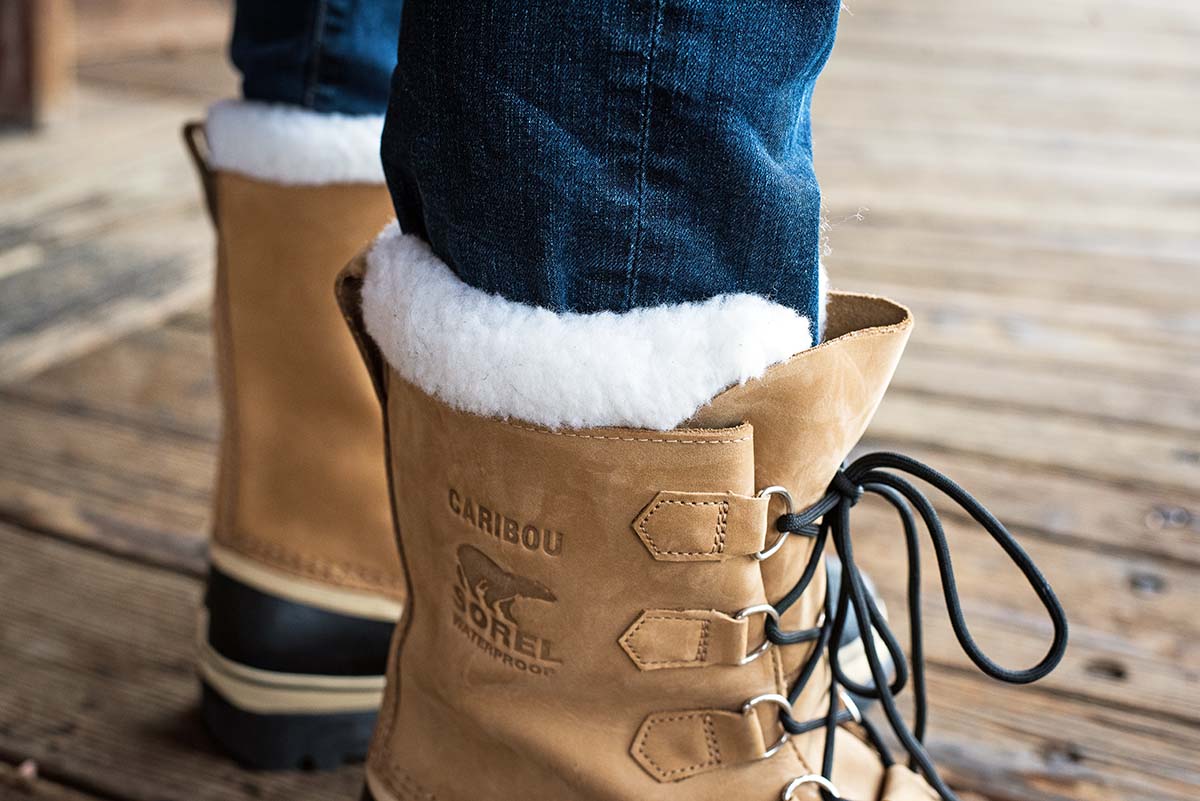
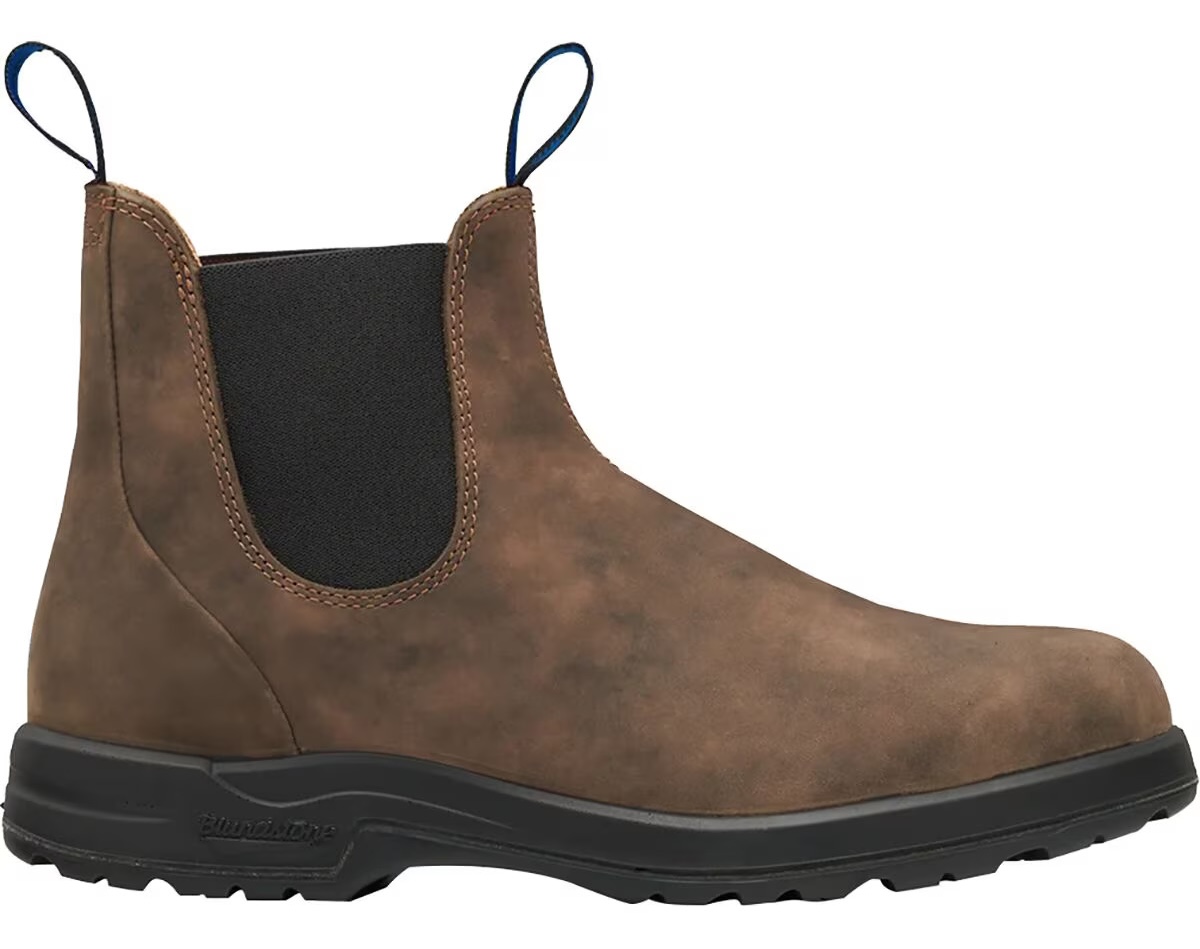 Category: Casual
Category: Casual
Insulation: 200g Thinsulate, sheepskin insole
Shaft height: 6 in.
What we like: Classy looks and premium build quality with a Vibram outsole.
What we don’t: Pricey and short height limits versatility.
We love a well-done Chelsea boot, and Blundstone leads the pack in this department for a reason. One of our editors has two pairs in non-stop seasonal rotation: a regular version for warmer months of the year, and the All-Terrain Thermal for cooler, sloppy shoulder-season conditions and winter. The All-Terrain Thermal ups the ante on the standard version by adding waterproof leather, water-resistant elastic with latex seams, a 200g Thinsulate lining, a cozy sheepskin insole, and a grippy Vibram outsole. Every aspect screams quality, and, while this is a decidedly casual option, we've witnessed Blundstones hold their own everywhere from farms and ranches to ceramic studios and casual trails. If you take care of the leather, this impressive shoe will reward you well in the long run.
That said, the lower shaft height on this urban-leaning boot means that your options are more limited when it comes to navigating deep snowdrifts. And while the sole is decidedly grippy, you'll still need to be mindful on ice (though that's true of pretty much any boot here, to varying degrees). You'll also want to factor in some break-in time—as with most leather shoes, the Blundstone Thermal is stiff at first, and the small opening can take some oomph to pull over your heel. Thankfully, the front and back pull loops are strongly attached and can take years of yanking without issue (trust us, we know). Lastly, the cost for entry to the hip Blundstone club is not cheap. You can save $55 to $65 with the non-thermal, non-all-terrain version, but this will limit winter usefulness even more. At the end of the day, this likely won't be your one-and-only winter boot, but it's a great option to have for milder days when you want to cut some bulk and feel a bit more dressed up.
See the Blundstone All-Terrain Thermal
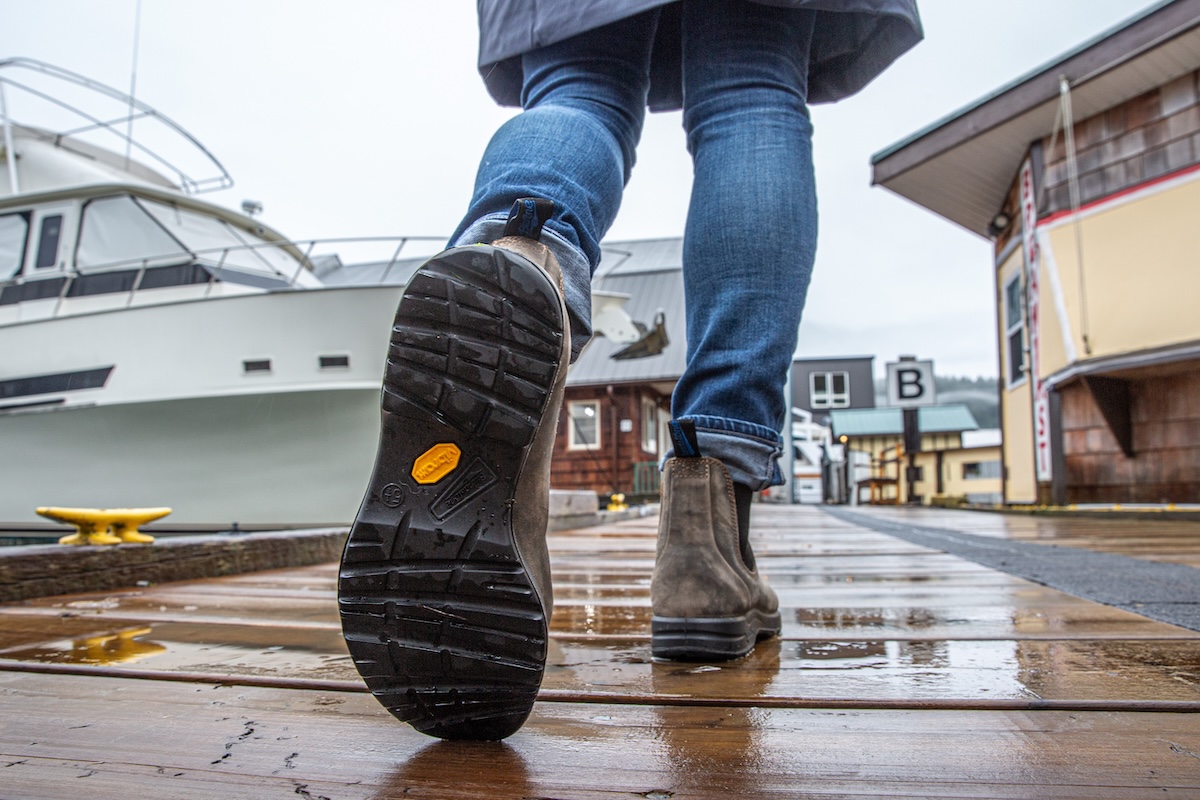

Category: Winter hiking/casual
Insulation: 200g M Select Warm
Shaft height: 6 in.
What we like: Light, reasonably nimble, and not overly insulated for active use.
What we don’t: Relatively low height impacts warmth and protection.
Merrell specializes in hiking footwear, so it should come as no surprise that their Thermo Chill is a great option for winter hiking. The Thermo Chill Mid takes a fairly standard hiking boot design and gives it a cold-weather treatment, with a bit more height than a typical hiking boot, a sturdy leather upper, waterproof lining, and proprietary 200g insulation that kept us comfortable while hiking in temps ranging from the mid-teens to low 30s Fahrenheit. The roomy toe box pairs well with heavyweight socks (something a surprising number of boots don’t allow), and the boot has a decently light and nimble feel. All told, the Merrell Thermo Chill is a solid pick for long winter walks, hikes, and snowshoeing.
We love the Thermo Chill’s low profile for hiking, but it’s a sizable trade-off in particularly snowy or cold conditions. The 200g insulation is sufficiently warm when on the move, but we wound up with cold toes during more sedentary activities with temps around 20°F. Additionally, the low 6-inch shaft height means you’ll need gaiters in moderately deep snow. It's worth noting that there are stiffer and more supportive options on the market—like the Oboz Bridger below—which is helpful if you'll be hauling a heavier backpack. Additionally, if you like the Thermo Chill but would prefer a boost in warmth and traction, Merrell's own Moab Speed 2 Thermo is also worth a look. The trade-off for these upgrades is a significant bump up in price: $210 for the Oboz and $190 for the Moab. Overall, the Thermo Chill is an excellent performer on the trail and holds its own for around-town use, too—and it’s a standout value at just $150.
See the Men's Merrell Thermo Chill 2 Mid See the Women's Thermo Chill 2 Mid
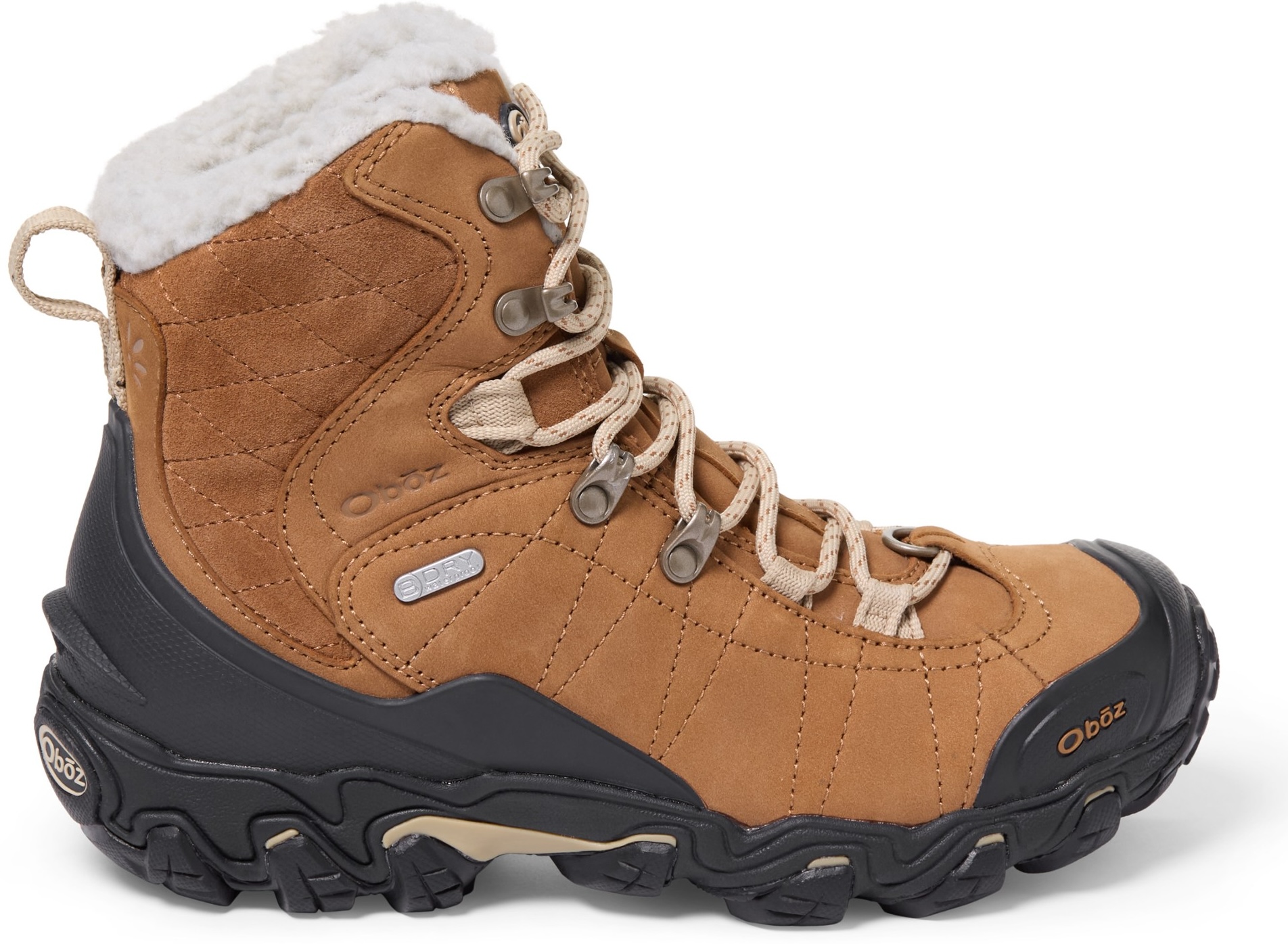 Category: Winter hiking
Category: Winter hiking
Insulation: 200g Thinsulate
Shaft height: 7 in.
What we like: Stylish and also great for casual use; well-built; comfortable.
What we don’t: The wool around the ankle can become wet and transfer it to your socks.
Like the men's Merrell boots above, the women's Oboz Bridger 7” Insulated takes a solid hiking boot design and gives it a healthy winter revamp. To increase the boot’s protection from snow, the Bridger 7” is taller by a few inches and features 200g Thinsulate insulation along with a cozy and stylish wool collar. You also get helpful hiking-specific features like a gaiter ring at the forefoot and a rubber tab at the heel for removing the boots hands-free (this also helps with securing snowshoes). And we were happy to see that Oboz retained most of the flagship Bridger’s light and nimble feel. Finally, the lacing system does a great job providing a secure fit—a stark contrast to the budget-friendly Momentum 3 above, which features bungee laces that are more prone to slippage.
We were impressed with how warm our feet stayed in the Bridger, even for our testers whose feet run cold. That said, if you want even more protection, Oboz makes a 9-inch version for women (and a 10-in. version for men) with 400g insulation for only $10 more. We’ve also found that because the cut is lower at the back, it allows snow to enter the boot if you're not wearing gaiters. Subsequently, the wool, which is lovely for blocking drafts, collects snow and allows moisture to settle into the boot (the men's version doesn't suffer from this, as the cut of the neck is straighter and there's no wool cuff). After a true snow outing, our feet were sometimes quite wet, though the boots still kept our feet warm, even with wet socks. Finally, while the outsole grips well on soft snow and hard-packed dirt, the directional lugs result in less aggressive traction on packed snow, mud, and ice—so don’t forget your winter traction devices. These downsides hurt the Bridger Insulated’s all-around appeal a bit, but it’s nevertheless an excellent performance choice if you love to hike in the colder months.
See the Women's Oboz Bridger 7" Insulated See the Men's Oboz Bridger 8" Insulated

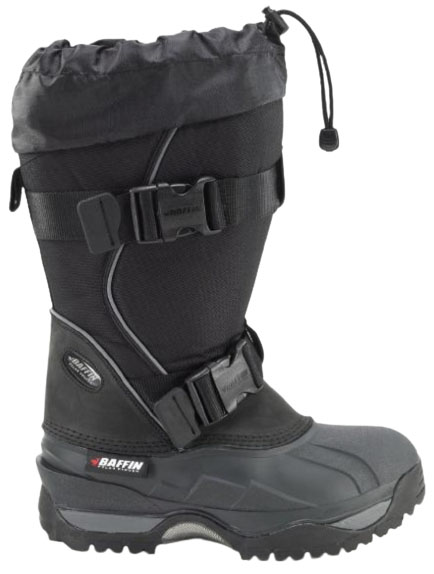 Category: Work
Category: Work
Insulation: 8-layer lining
Shaft height: 15 in. (men's), 12 in. (women's)
What we like: Truly ready for -50-degree temperatures.
What we don’t: Not night-out-on-the-ski-town compatible; women's version is much more expensive.
The Baffin Impact is an exercise in excess, but if you’ll be outside in sub-zero temperatures for extended periods of time—think ice fishing or outdoor work in places like the Upper Midwest, Montana, or Alaska—it’s in a class of its own. The boot is insulated with an eight-layer system of foam and polyester, which is encased in a burly nylon and rubber shell. Winter boots are notorious for having ambitious temperature ratings (usually -25°F to -40°F), but the Impact is what Baffin calls "Polar Proven", with their testing team allegedly staying comfortable down to temperatures between -49°F and -76°F. We haven't tested that claim (at least not yet), but this aligns with user reviews we've read over the years as well. As cold-weather boots go, this is about as good as it gets.
The downside to so much warmth is that the Impact doesn’t handle mild winter conditions well and isn’t breathable. The boot also weighs over 7 pounds for the men's pair and close to 6 pounds for the women's, has an extremely tall shaft height (15 in. for the men's boot and 12 in. for the women's), and is pretty bulky and ungainly, so it’s not intended for covering much ground. Additionally, the price difference between the two genders is truly baffling to us (we reached out to Baffin and they suggested women just buy a men's boot by sizing down two sizes). These things aside, for areas of the country where the temperatures consistently dip well below zero, we heartily recommend protecting yourself with the Baffin Impact. For a more modern-looking alternative from Baffin that still offers serious insulation, check out their Snow Monster ($330) for men, which is rated down to -94°F, or the more fashion-forward Chloe boot ($234) for women.
See the Men's Baffin Impact See the Women's Baffin Impact

Category: Work
Insulation: 5mm neoprene, fleece lining
Shaft height: 16.5 in. (men's), 16.9 in. (women's)
What we like: Fantastic foot protection, traction, and warmth.
What we don’t: Rather heavy and hard to take on and off.
Insulated rubber boots are a popular choice for working outside and walking through brush while hunting due to their fantastic protection from water, ice, and mud. The Muck Boot brand is a standout in this category, and one of their proven best sellers is the Arctic Sport. This boot features a durable rubber exterior, thick and flexible neoprene bootie, and a soft-touch fleece lining that does a great job maximizing comfort and warmth. We’ve worn the Arctic Sport daily throughout the winter in Washington’s Central Cascades and all around Lake Tahoe in California, and it has deftly handled everything from waist-deep snow to spring slush. In addition to keeping the elements out, the boot offers solid warmth (Muck Boot gives a generous -40 to 40˚F temperature rating) and ridiculously good coverage—now that we’ve experienced the almost knee-height shaft, we don't want to wear anything else when it's wet and mucky out.
Muck Boot and Bogs are longtime rivals in the insulated rubber boot market. The Bogs Classic Insulated (below) excels for casual wear and is more affordable, but in rough weather and conditions, we give the edge to the Arctic Sport. The biggest downside is the boot’s lack of breathability—if you’re building up heat while shoveling the driveway or walking more than a few blocks, things can get fairly swampy inside. We’ve also found the knee-height design a bit of a bear to get on and off—a downside we’re willing to put up with—and the sole isn’t particularly grippy on ice (for better traction, check out the $210 Arctic Ice). But overall, Muck Boots are the crème de la crème of work boots, and the premium construction should last you many seasons of hard use. If you don’t need the full calf coverage, Muck Boot also makes the Arctic Sport in a 13-inch-tall Mid version for $170 (or $145 for the 12.2-in. women's Arctic Sport II Mid).
See the Men's Muck Boot Arctic Sport Tall See the Women's Muck Boot Arctic Sport II Tall

Category: Winter hiking/casual
Insulation: 200g PrimaLoft
Shaft height: 7 in.
What we like: Great looks and all-around performance.
What we don’t: Expensive and side zipper doesn't work great with laces tightened.
Winterizing a popular hiking boot is not a new trend, but Danner’s Arctic 600 stands out as one of the best efforts yet. Starting with their popular Mountain 600 boot, the brand added high-quality 200g PrimaLoft insulation, Vibram’s snow- and ice-specific Arctic Grip outsole, and nice touches like exposed wool on the collar and tongue. Further, there’s a zipper along the instep of each boot to ease the on-and-off process. Just as important, however, is what they retained: The smooth exterior looks great just about everywhere, and the Arctic 600 feels light and energetic for a winter-ready design.
What keeps the Danner from ranking higher on our list is value. Simply put, it’s hard to justify the steep $290 price tag (though some colors made with a less premium leather are available for $240-250). For around half the price, you can get Merrell's Thermo Chill above, which stacks up closely to the Danner in all-around performance and comfort with a well-padded interior and versatile 200g insulation, although it lacks the premium Vibram tread, high-quality leather, and overall style. And the Danner’s build quality can't be ignored (read: better long-term durability); one member of our team recently wore these over several hours in temps that reached single digits Fahrenheit, staying warm the entire time. The design is also one of only a few on the market that’s equally as comfortable in the city as it is exploring a snowy forest service road.
See the Men's Danner Arctic 600 Side-Zip See the Women's Danner Arctic 600 Side-Zip
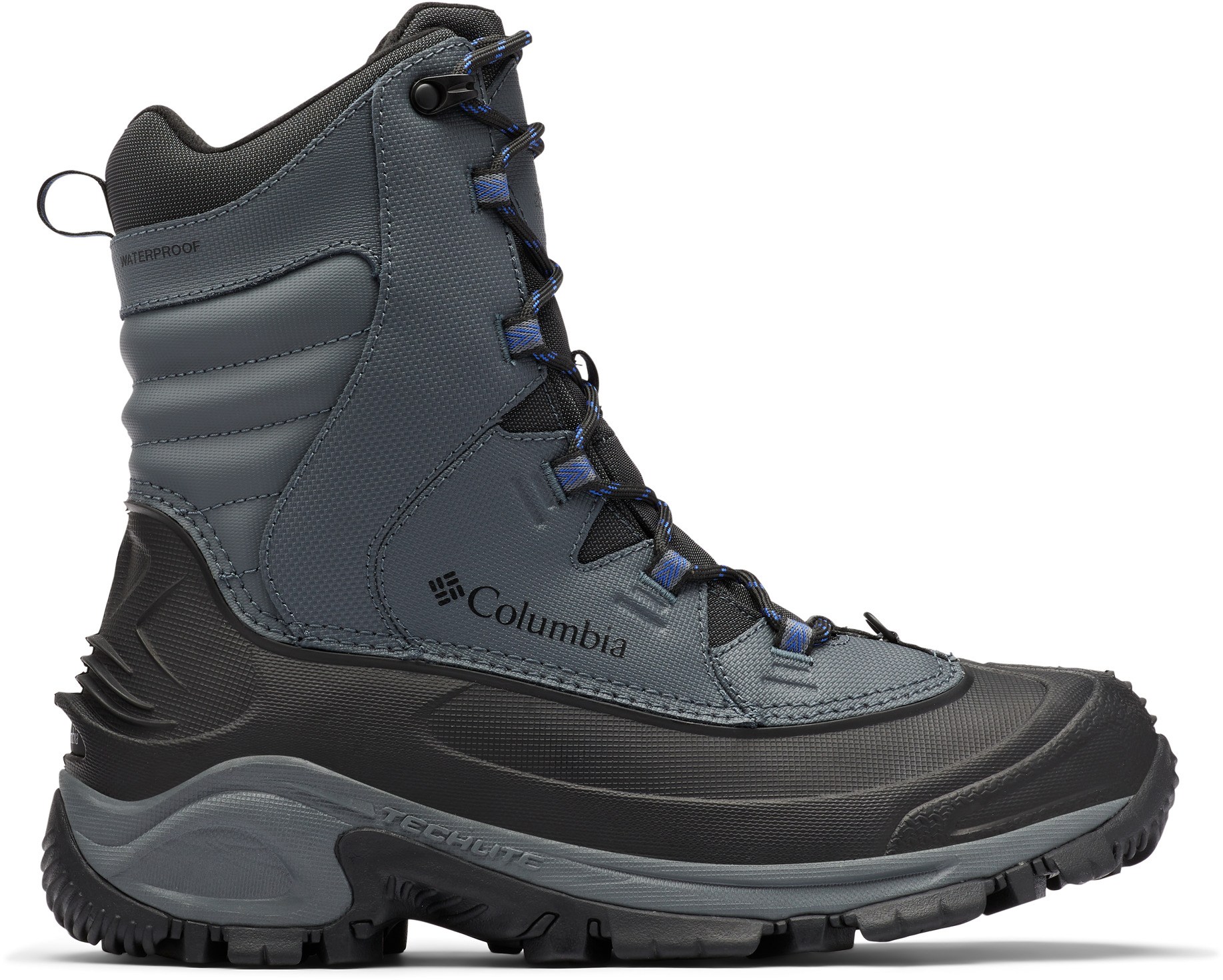 Category: Casual/work
Category: Casual/work
Insulation: 200g synthetic
Shaft height: 7 in.
What we like: Decently warm and rugged; excellent price.
What we don’t: Heavy for hiking; middling protection in deep snow.
Columbia’s Bugaboot has long been a staple in the winter boot category, and the third iteration carries that tradition forward. The 200g synthetic insulation is nothing mind-blowing but hits a sweet spot for milder winters, and Columbia's Omni-Tech construction delivers a waterproof finish that still manages to stay decently breathable. The rest of the boot is nicely styled for the rigors of wintertime use, with a leather upper and sturdy Omni-Grip outsole designed to grip on cold and slippery ground. From slushy hikes to running errands in the snow, the Bugaboot is equipped to tackle most winter conditions.
What are the downsides of the Columbia Bugaboot III? Given the lighter insulation, this boot wouldn't be our first choice for sustained outdoor use—it's better suited for mild temps and folks who prefer a boot they can wear inside without overheating. And while the Bugaboot boasts a lightweight and well-cushioned midsole, the boot is quite a bit heavier than we would prefer for a dedicated hiker (for reference, the Merrell Thermo Chill above is around 14 oz. lighter per pair when comparing the men's versions). Finally, while the mid-height shaft offers decent protection, we’d prefer a taller cut in deep snow. That said, for a capable all-rounder at a steal of a price, we do really like the latest Bugaboot.
See the Men's Columbia Bugaboot III See the Women's Columbia Bugaboot III
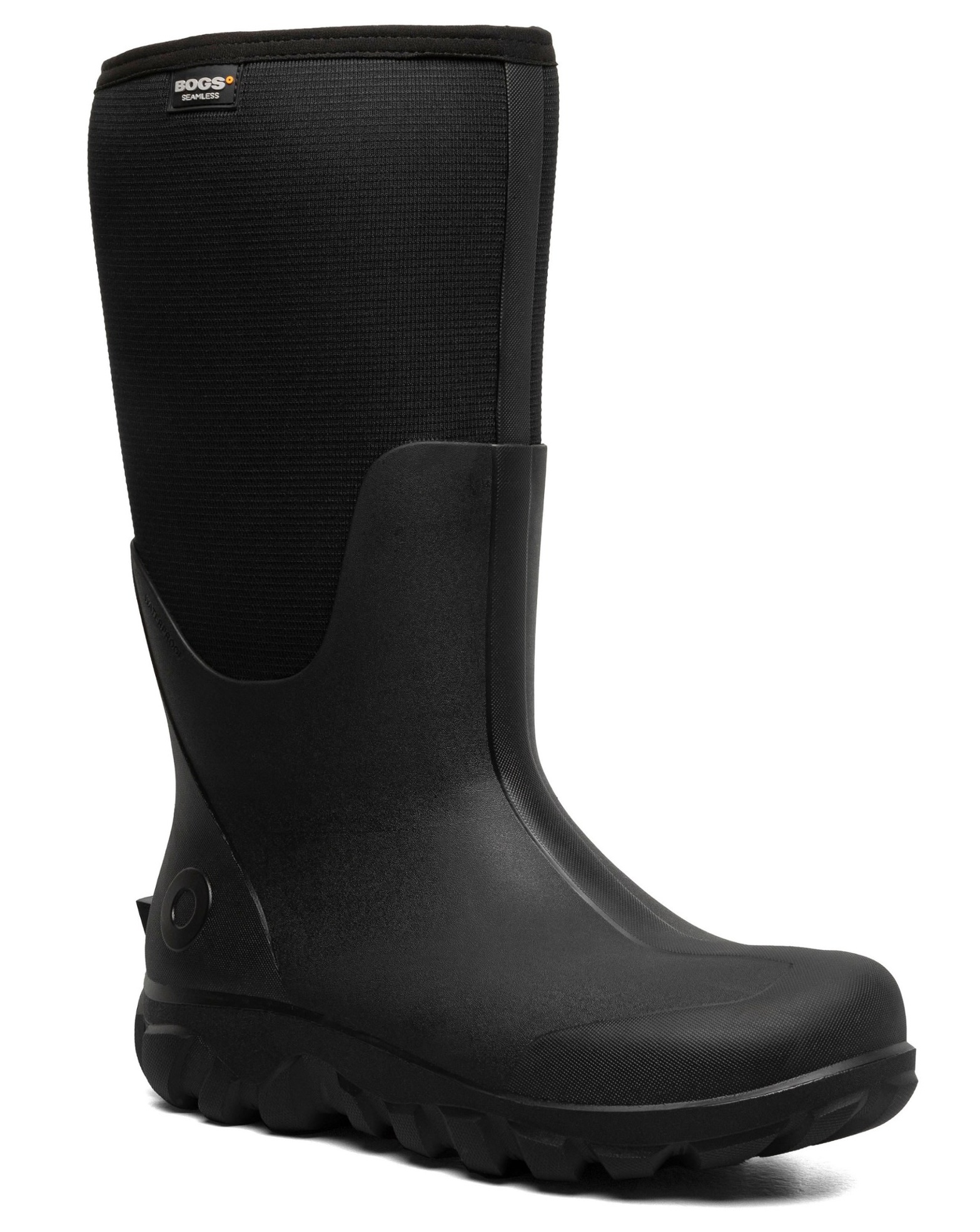 Category: Work
Category: Work
Insulation: 5.5mm NeoTech
Shaft height: 15 in. (men's), 14.3 in. (women's)
What we like: Simple, warm, and surprisingly good-looking.
What we don’t: Heavy, men's version lacks handles, women's version omits air mesh layer.
Bogs' Classic Seamless Tall takes the signature look of a rain boot and adds a healthy dollop of warmth and protection. A thick neoprene construction gives these boots impressive warmth, though it does fall a little short of the Muck Boot above. The Bogs’ lower profile makes it well-suited for daily wear—as does the flexible neoprene upper material—and it’s a classic choice for running to and from classes in cold places like the Midwest. Predictably, this boot is also extremely waterproof and holds up very well in slushy conditions. The women's Classic provides cut-outs as handles for easy on and off, though this does mean the flood height is lower.
Keep in mind that the Bogs Classic Seamless is best for use around town or for work, as it's a heavy boot (4 lb. 10 oz. for the men's and 4 lb. 3 oz. for the women's). This boot also lacks the precise fit we look for in a hiking option, though the newest version has an updated heel for improved stability and traction. Historically, traction and warmth fall short of the Muck Boot Arctic Sport for us, but the Bogs Classic Seamless is a great value at $150, and hits a nice middle ground for everyday and occasional rough use.
See the Men's Bogs Classic Seamless Tall See the Women's Bogs Neo-Classic Tall Insulated

Category: Casual
Insulation: 200g synthetic
Shaft height: 7 in.
What we like: Extremely lightweight and minimalist, a rarity for snow boots.
What we don’t: Not everyone will like the zero-drop design or lack of structure.
Are you someone who runs and hikes in minimalist or zero-drop shoes like the Altra Lone Peak for as long as you can to avoid switching to bulky, heavy, and awkward winter boots? If so, the Xero Alpine Snow Boot might be just the ticket. Weighing well under 2 pounds for the pair, this is a great choice for wider feet and anyone who appreciates being able to feel more of the ground beneath them. A removable insole helps you tailor how much of this feel you want, as well as provide more or less room for different sock thicknesses. Seam-sealed inner booties step up the waterproofing, and with 200g insulation, most folks will stay warm down into the 20s Fahrenheit or below.
The downside to such a streamlined design is that a thinner sole means more potential for sore or fatigued feet. If you don't wear a shoe like this regularly, the differences will be stark. We recommend gradually increasing your mileage and having an additional pair of boots on standby in the meantime. The shaft of the Xero Alpine is warm and cozy but also less structured than a traditionally burly option like the Sorel Caribou or TNF Chilkat above. But if you prefer less bulk and want a boot that wears and feels more like your favorite trail runners, Xero is a great brand to explore. A bonus is that Xero has one of the best warranty programs we've seen for boots: 24 months for defects and a hefty discount on sole replacement if you wear them down to 1 millimeter or less over 5,000 miles.
See the Men's Xero Shoes Alpine Snow Boot See the Women's Xero Shoes Alpine Snow Boot
| Boot | Price | Category | Height | Insulation | Weight |
|---|---|---|---|---|---|
| The North Face Chilkat V 400 | $159 | Casual/work | 8 in. | 400g Heatseeker Eco | 3 lb. 2.3 oz. |
| Kamik Nation Plus | $100 | Casual/work | 10 in. | 145g Heat-MX | 3 lb. 9.6 oz. |
| Sorel Caribou | $225 | Casual/work | 10 in. | 9mm felt | 4 lb. 10 oz. |
| Blundstone All-Terrain Thermal | $275 | Casual | 6 in. | 200g Thinsulate | 1 lb. 14.8 oz. |
| Merrell Thermo Chill 2 Mid | $150 | Winter hiking | 6 in. | 200g M Select Warm | 2 lb. 8 oz. |
| Baffin Impact | $216 | Work | 15 in. | 8-layer lining | 7 lb. 6.7 oz. |
| Muck Boot Arctic Sport | $175 | Work | 16.5 in. | 5mm neoprene & fleece | 5 lb. 0 oz. |
| Danner Arctic 600 Side-Zip | $290 | Winter hiking | 7 in. | 200g PrimaLoft | 2 lb. 13.0 oz. |
| Columbia Bugaboot III | $120 | Casual/work | 7 in. | 200g synthetic | 3 lb. 6 oz. |
| Bogs Classic Seamless Tall | $150 | Work | 15.3 in. | 7mm NeoTech | 4 lb. 10 oz. |
| Xero Shoes Alpine Snow Boot | $175 | Casual | 7 in. | 200g synthetic | 1 lb. 13.8 oz. |
| Winter Boot | Price | Category | Height | Insulation | Weight |
|---|---|---|---|---|---|
| Ugg Adirondack XXV | $250 | Casual | 8/9.5 in. | 200g wool | 2 lb. 6 oz. |
| Kamik Momentum 3 | $110 | Casual | 11.75 in. | 145g Heat-MX | 2 lb. 4 oz. |
| Sorel Caribou | $225 | Casual/work | 9 in. | 9mm felt | 3 lb. 6 oz. |
| Blundstone All-Terrain Thermal | $275 | Casual | 6 in. | 200g Thinsulate | 1 lb. 14.8 oz. |
| Oboz Bridger 7” Insulated | $210 | Winter hiking | 7 in. | 200g Thinsulate | 2 lb. 9 oz. |
| Baffin Impact | $276 | Work | 12 in. | 8-layer lining | 5 lb. 11.2 oz. |
| Muck Boot Arctic Sport II Tall | $155 | Work | 16.9 in. | 5mm neoprene & fleece | 4 lb. 0 oz. |
| Danner Arctic 600 Side-Zip | $290 | Winter hiking | 7 in. | 200g PrimaLoft | 2 lb. 5 oz. |
| Columbia Bugaboot III | $120 | Casual/work | 7 in. | 200g synthetic | 3 lb. 4 oz. |
| Bogs Classic Seamless Tall | $150 | Work | 14.3 in. | 5mm NeoTech | 4 lb. 3 oz. |
| Xero Shoes Alpine Snow Boot | $175 | Casual | 7 in. | 200g synthetic | 1 lb. 8.4 oz. |
Winter means snow in most parts of the U.S., and as a result, many staff members at Switchback Travel spend a lot of time out in the rain, cold, and muck. Former editor-in-chief John Ellings put together our initial list of winter boots back in 2015, drawing from years of experience throughout the Pacific Northwest. Current editor-in-chief Penney Garrett started contributing in 2024 from her home base in Lake Tahoe, where being properly outfitted and comfortable outside in the winter is a necessity. Penney lived in Colorado's Rocky Mountains for decades before moving farther west and spends the bulk of her winters moving snow (via shovel and snowblower) or sliding through it on skis. With input from our broad network of testers, the Switchback team knows how to stay comfortable and agile in the gnarliest weather, and good footwear is no small part of that equation.
Our current lineup reflects our ongoing boot testing experiences, firsthand info from testers and gear-savvy friends, and feedback from the online community. When testing winter boots, we look closely at factors like comfort, waterproofing, warmth, flex, shaft height, and weight. We do our best to test longstanding designs over many seasons to also gain insight into long-term durability. And because the market is always growing and changing, we regularly update our lineup as new and noteworthy designs become available. We try them out firsthand and only add them to our list above if they are truly worthy.
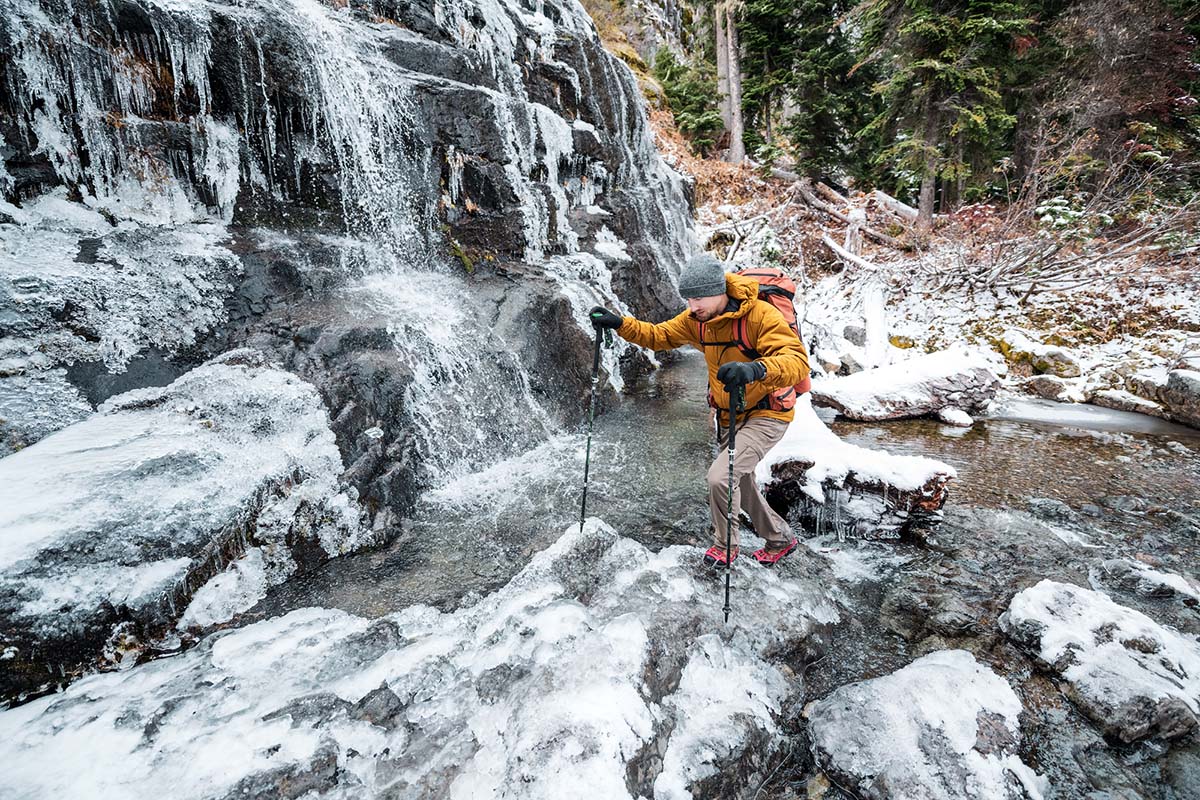
Casual
Casual or everyday winter boots are not the absolute warmest or best at resisting the elements, but they offer plenty of both for most winter walking and après-ski activities. The constructions of casual boots tend to have less rubber and more leather and suede, although some models, including the Sorel Caribou, do a great job at incorporating both. Other commonalities include a moderate level of insulation and well-cushioned interiors that will keep most people warm and comfortable while shoveling or on short jaunts out of the house. Insulated Chelsea boots (like the Blundstone Thermal) also fit into this category—while we don’t recommend these for sustained outdoor use in the snow, they’re perfect for commuting, and they transition well to indoor environments. Some of our favorite casual boots include The North Face Chilkat V 400, Sorel Caribou, and budget-friendly Kamik Nation Plus.
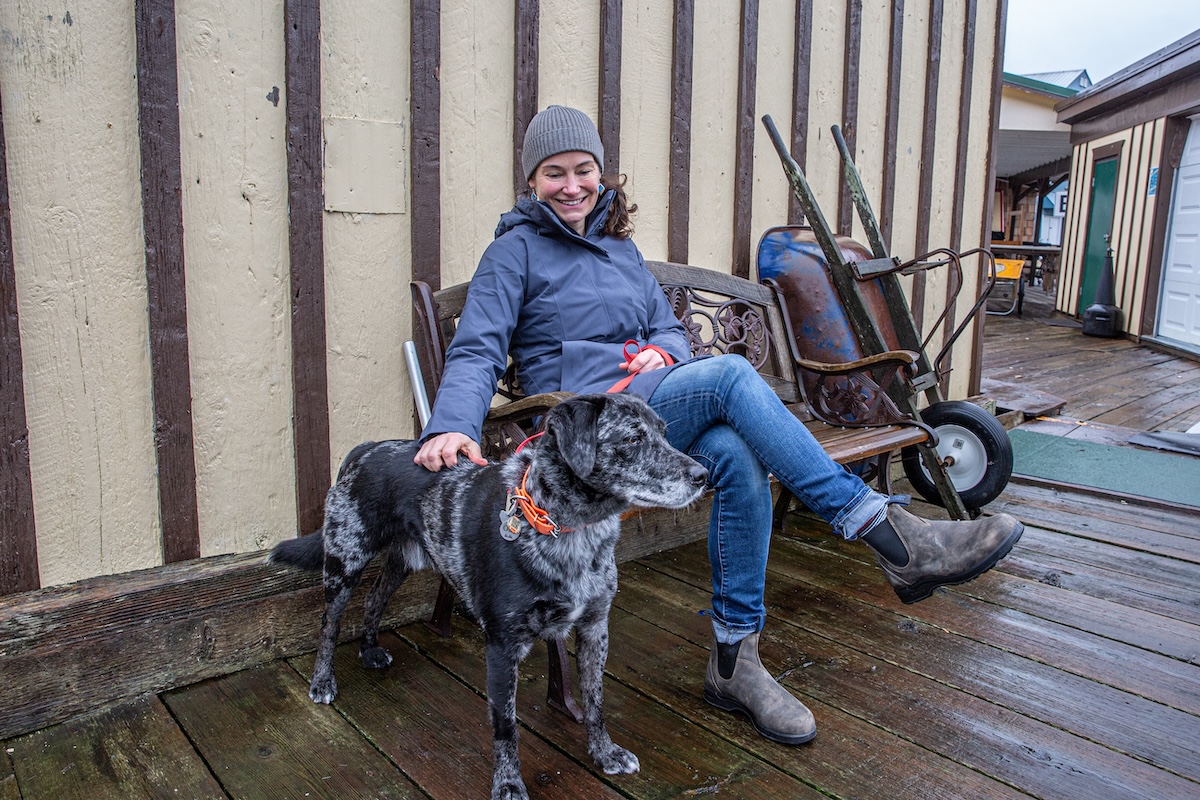
Winter Hiking Boots
Looking a lot like beefed-up hiking boots—because they are—winter hikers are a great choice for snowshoeing and other hiking adventures in the cold. These models typically have a lower ankle height and less insulation than other boot types, which allows them to breathe reasonably well when you’re working up a sweat. Further, their more flexible and nimbler designs make it easier to cover serious ground. Traction is another important feature, and it’s here that you’ll see some of the more advanced tread designs with rubber that grips well even on frigid and icy surfaces. Leading models in this category include the Merrell Thermo Chill and Oboz Bridger Insulated, as well as the Danner Arctic 600 Side-Zip.
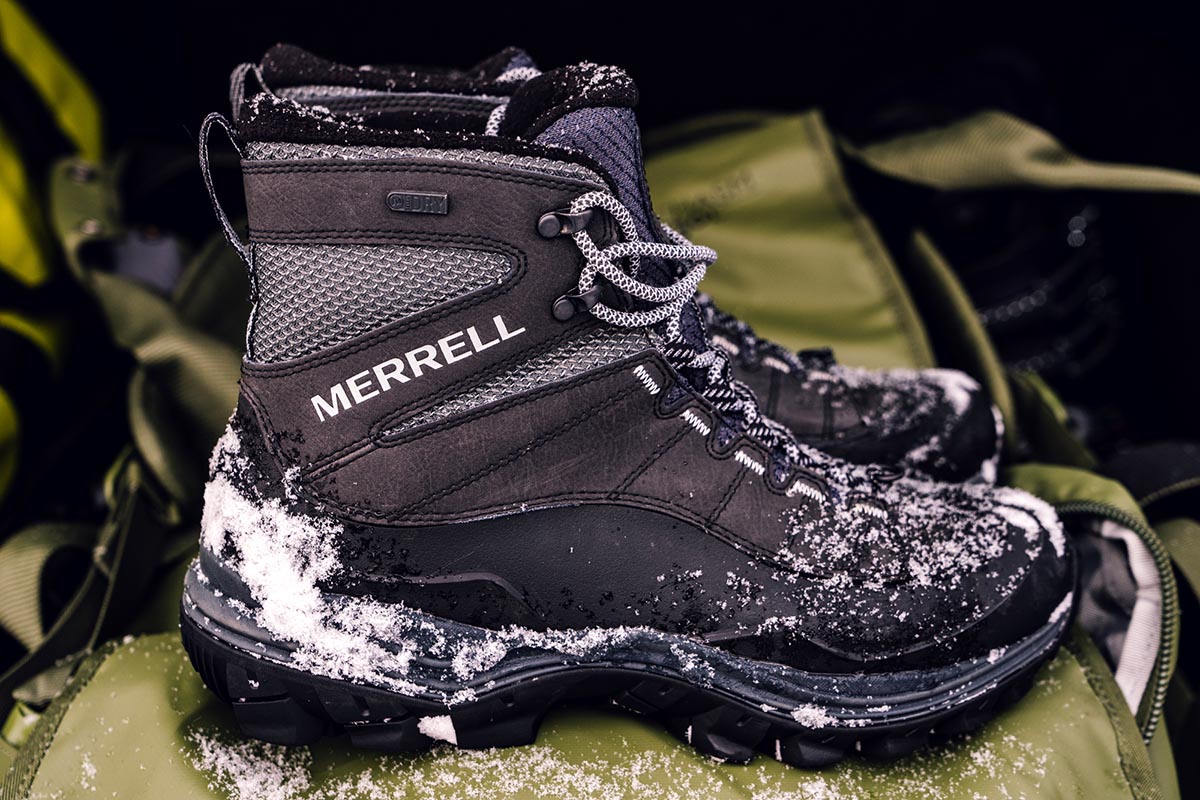
Work/Extreme Cold Winter Boots
Made for the depths of winter and the coldest parts of the world, these boots are big, bulky, warm, and tough. They also take the function-over-fashion approach with heavy applications of rubber, nylon, and/or thick leather that perform best in frigid temperatures and deep snow. Keep in mind that the heavy construction does add weight and bulk, and you won’t want to cover major distances with 5+ pound boots like the Baffin Impact. They’re also often too stiff to safely use while driving. Instead, what you get is a super high level of warmth that is great for low-output activities in sub-zero temperatures.
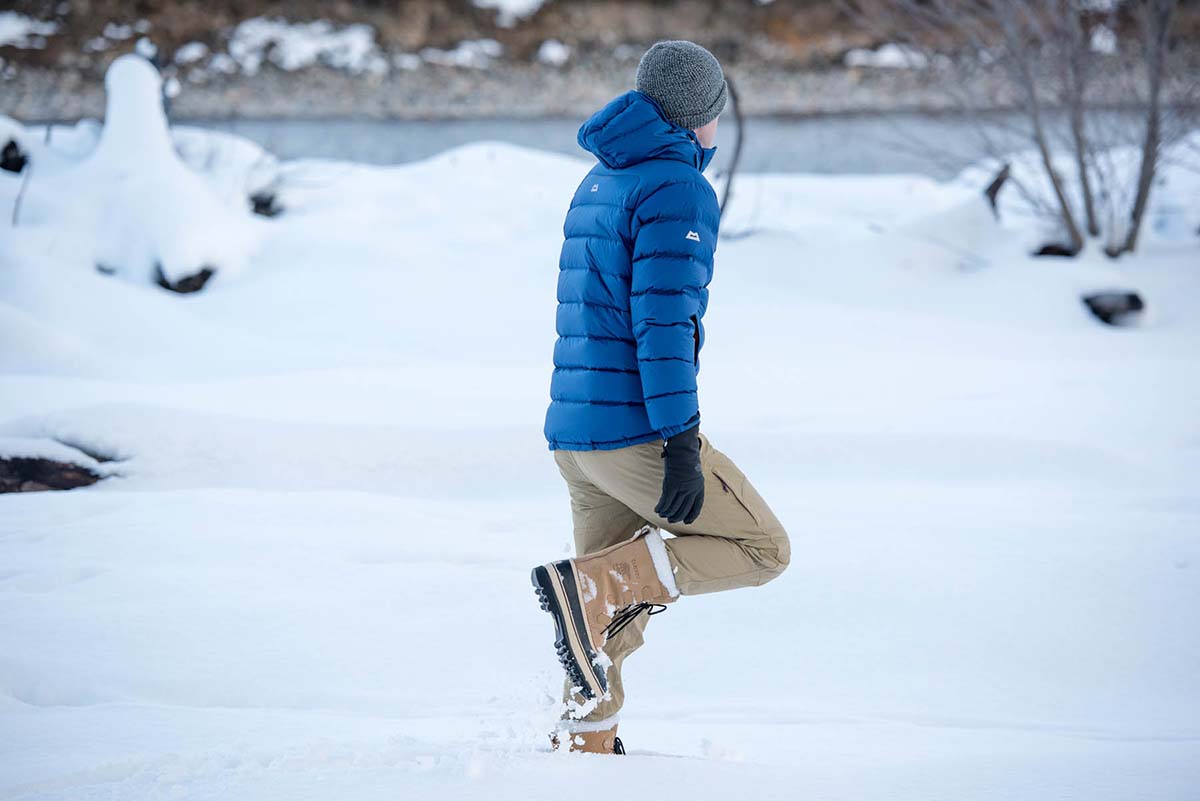
Some, but not all, brands will include a comfort or temperature rating for their winter boots, and it's often an impressive number, in the realm of -25°F or lower. Right off the bat, let’s be clear: There is no standardized test to rely on for measuring a temperature rating. As such, comfort ranges are not a guarantee that you’ll be warm at the listed temperatures. In fact, we can almost guarantee you will not be—particularly if you’re standing still. As we all know, how well a boot keeps you warm is dependent on a number of individual factors, including age, level of activity, the thickness of your socks, and whether or not you run hot or cold. We recommend using the comfort ranges as basic guidance, but stay very conservative with your real-world use.
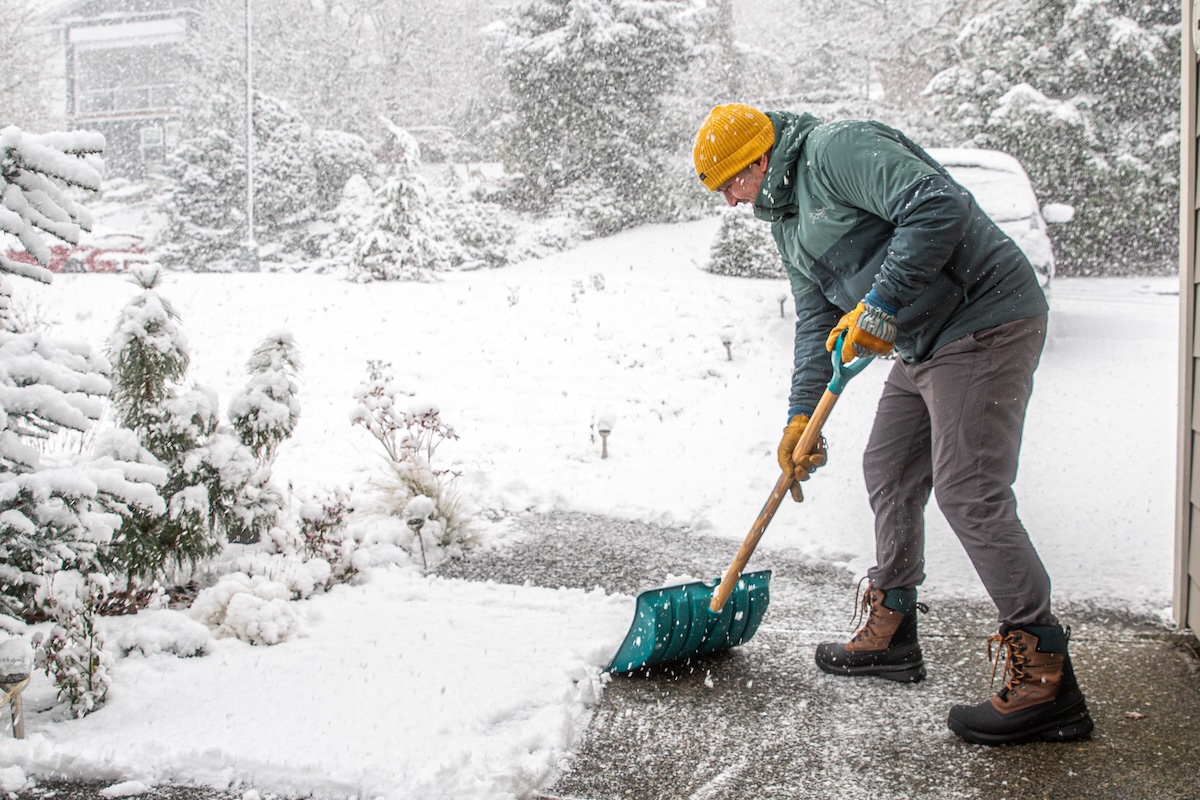
Synthetic
The most common insulators nowadays are synthetics stuffed between the inner lining and outer shell of a boot. PrimaLoft and Thinsulate by 3M are popular insulations that have a strong presence in the jacket, glove, and ski boot world, and have equal standing with winter boots. They’re non-bulky, lightweight, and continue to insulate even when wet. Proprietary synthetic insulations for The North Face (Heatseeker) and Columbia (Omni-Heat), among others, offer comparable performance to the name brands. For an indicator of warmth, check for the number of grams being used in the boot (measured by weighing a 1 meter by 1 meter section). Light to midweight boots will have 200g to 400g fill, while heavy-duty cold-weather boots will have significantly more.
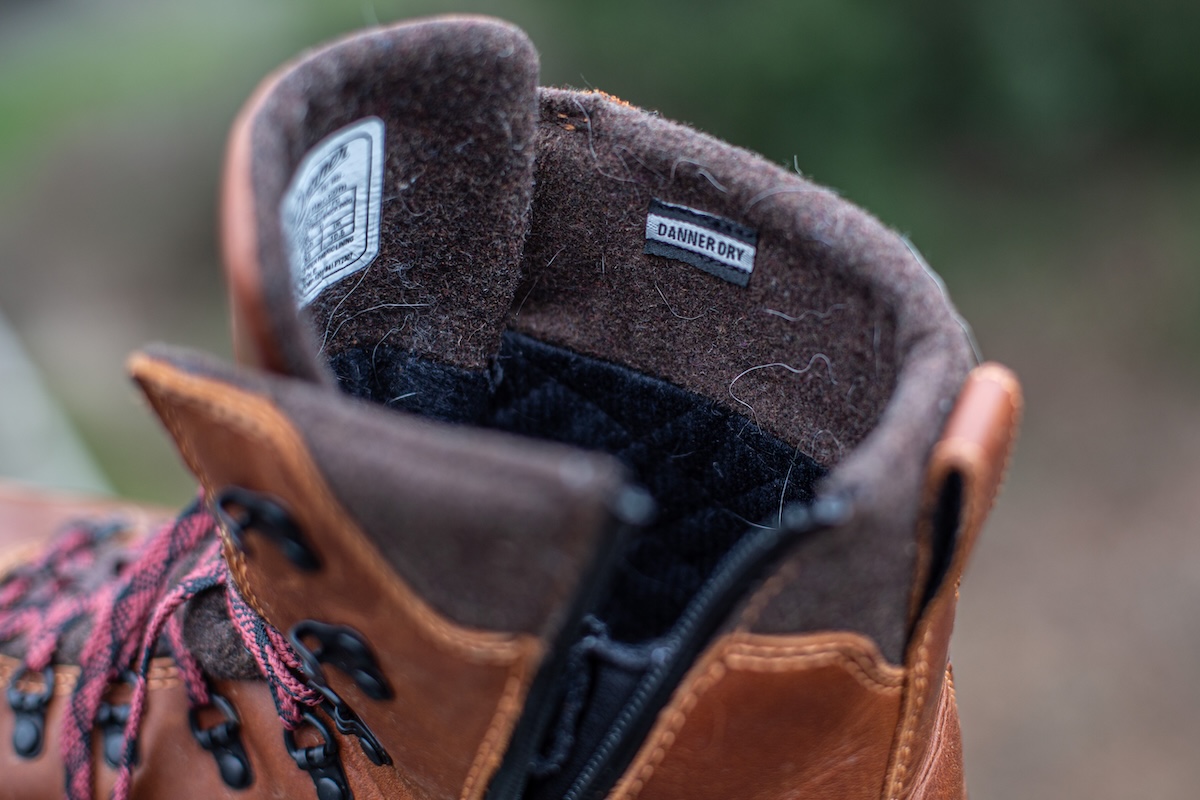
Felt, Sheepskin, and Wool Linings
Some boots eschew modern technology and opt for warmth through a thick lining of felt, sheepskin, or wool, including the classic Sorel Caribou and Ugg Adirondack XXV. While bulky, these insulation types can be really effective. Unlike synthetic insulation that is encased by the boot, felt, sheepskin, and wool linings can get wet if exposed to the elements, but they will continue to insulate. The nice part is that many of these linings are removable (boots with an entirely removable lining are often referred to as "pac boots"—more on this below), so you can set them by the fire to dry in between runs on the sled hill.
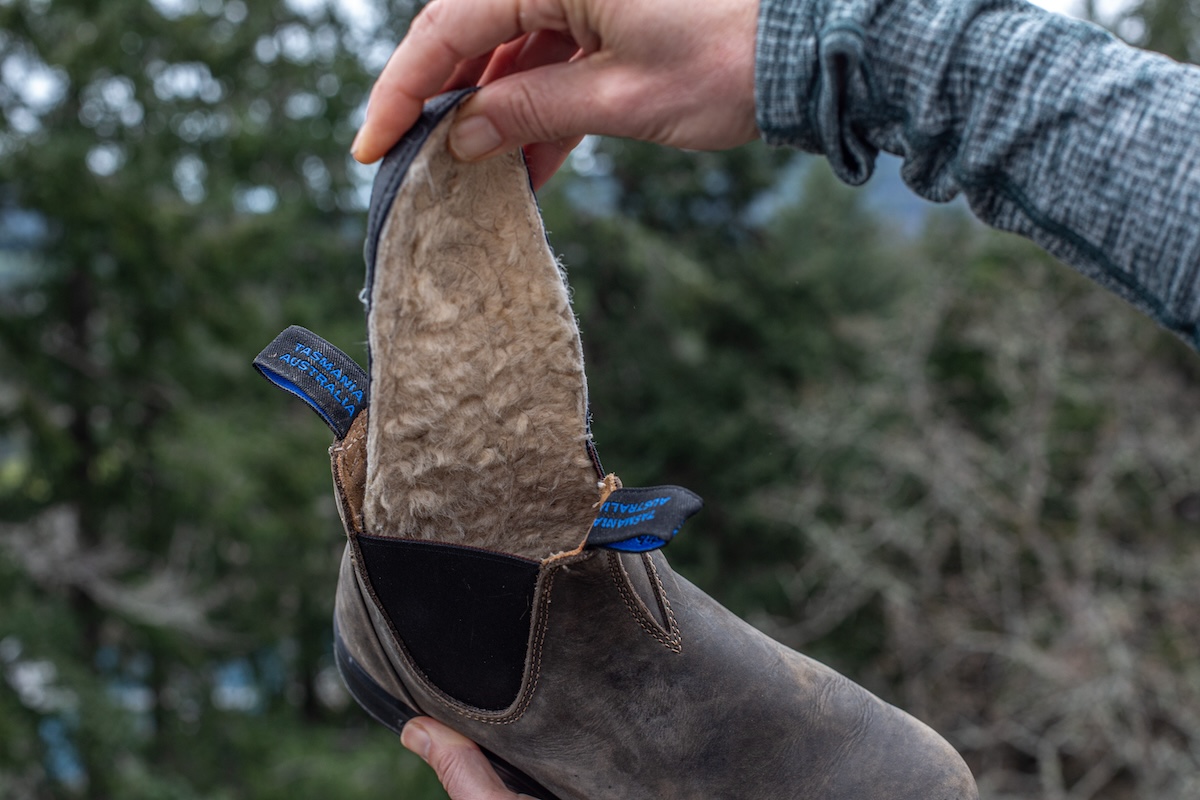
Down Fill
Down-insulated boots are not commonplace, and for times when you will be in direct contact with the snow (which can often be the case in winter), they are not the most secure option. This is because, unlike synthetic fills and natural materials like felt, sheepskin, and wool, down loses its insulating ability when wet. As such, we recommend steering clear unless you’re in the market for a very casual around-town boot or basecamp shoe for use exclusively inside your tent (such as the Feathered Friends Down Booties). It’s hard to knock the utility of a good down bootie for indoor use, but in most cases, these are not meant to be taken outdoors.
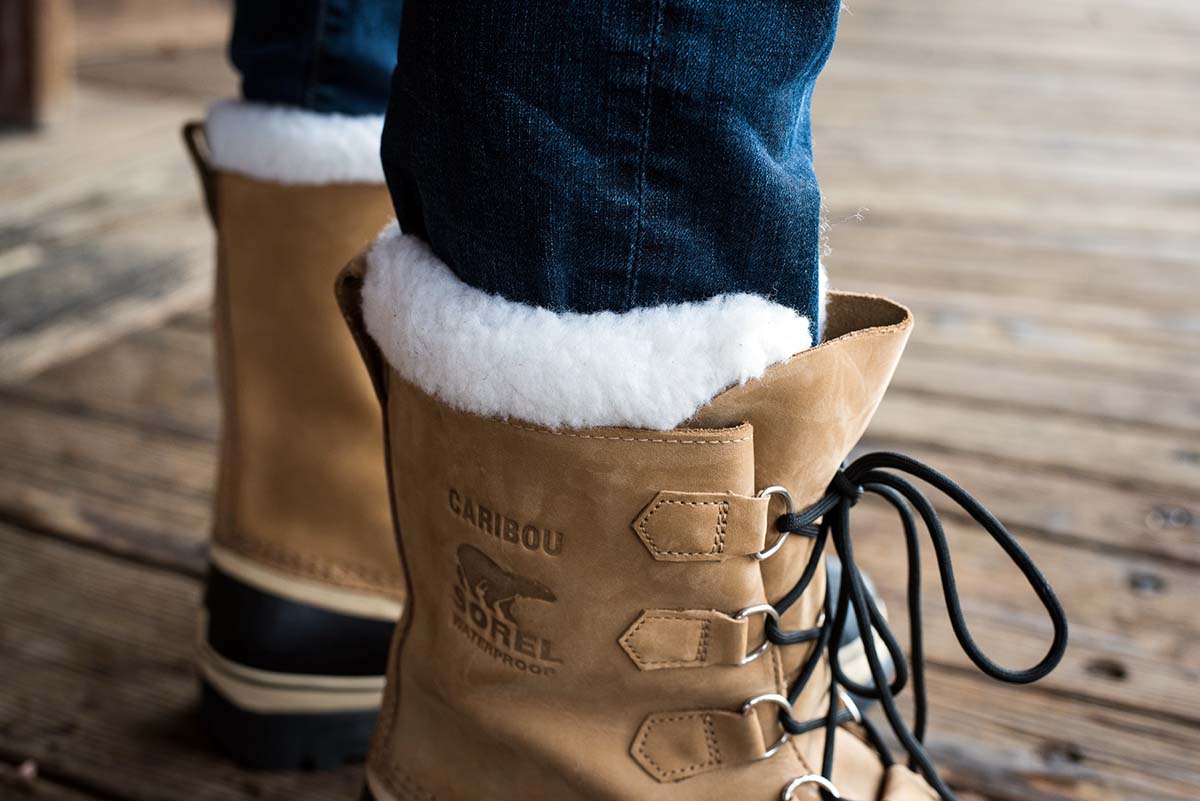
Winter boots have a fairly wide range of heights, from just over the ankles to just below the knees. In general, their various heights fall in line with our categories (to see the specific heights for each model, which is measured from the footbed to the top of the boot, see our comparison tables above). At the low end of the spectrum are hiking models and casual Chelsea boots, which measure roughly 5 to 7 inches in height. This makes them lighter and more flexible, but they are more prone to having snow come in over the top of the boot if you’re post-holing in the deep stuff. The good news is that a pair of waterproof gaiters can help resolve this issue (more on gaiters below).
Work boots and full-on extreme weather models sit higher on the leg, including the 15-inch Baffin Impact (12-in. on the women's version) and the more than 16-inch Muck Boot Arctic Sport. It’s worth noting that the extra height does inhibit range of motion, and muck-style boots can be a real struggle to remove at the end of the day. Finally, boots in the casual category fall somewhere in the middle, with a number of options in the 6 to 10-inch range.
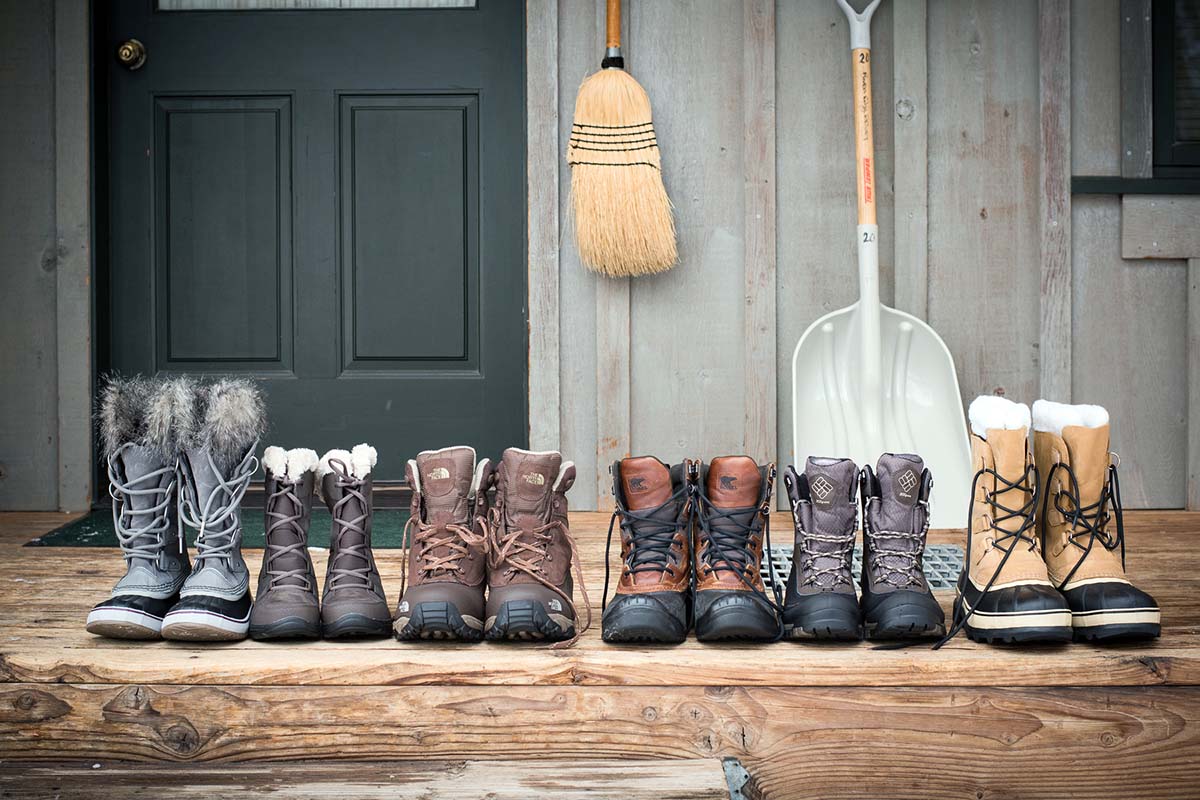
As with boot height, the weight of winter boots varies significantly. Unsurprisingly, the heaviest designs are meant for the worst conditions. Work-ready builds from Muck Boot and Bogs can reach over 5 pounds per pair, and the same is true for a burly boot meant for extreme conditions like the Baffin Impact. On the other end of the spectrum is the Merrell Thermo Chill, which weighs about the same as a standard hiking model at just 2 pounds 8 ounces for the men's (1 lb. 15.5 oz for the women's version), or the even lighter weight minimalist Xero Alpine at just 1 pound 13.8 ounces (1 lb. 8.4 oz. for the women's). For the most part, weight goes up as the level of insulation and coverage increases. One notable exception is something like the Steger Mukluks Yukon, which tips the scales at a very impressive 3 pounds for a pair of the men's, yet delivers Iditarod-worthy levels of warmth. It does, however, compromise elsewhere—the Mukluks aren’t particularly stable or grippy when hiking over difficult terrain.

Traditional winter boots like the Sorel Caribou and Kamik Nation Plus are two-piece designs with outer shells protecting insulated, removable liners. The advantages of this construction are that the boots are extremely tough: The rubber and leather exterior materials are very durable and waterproof, and they do a great job isolating you from the cold. Further, the removable liners are cushioned and soft, providing more comfort than a typical one-piece design. But perhaps the most significant feature of a removable liner is its ability to dry out more quickly when wet, a feature that’s especially vital for expedition use. These types of boots can feel a bit sloppy and ungainly when you’re covering long distances, but for short walks, outdoor work, and harsh conditions, a boot with a removable liner is a nice choice.
For active use like hiking or snowshoeing, or if you want to keep weight and bulk to a minimum, it’s better to go with a one-piece boot. These models often resemble a hiking design and offer a more precise fit and nimbler feel for greater control and stability in difficult terrain. They’re also lighter on average, which is a positive for longer walks and snowshoe trips. You do compromise a little protection, but quality one-piece designs like the Columbia Bugaboot III and The North Face Chilkat V 400 are still formidable options in harsh conditions.
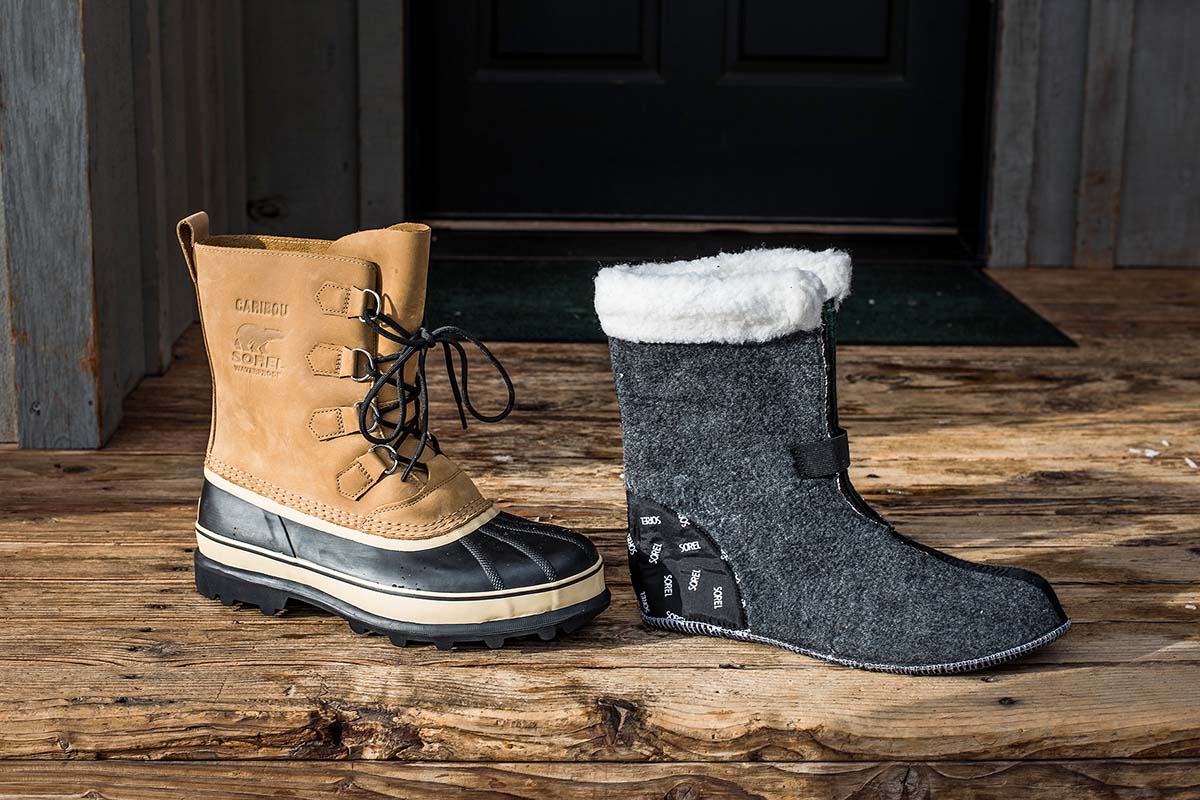
Considering that you might be spending a good amount of time walking in varying depths of snow, waterproofing matters. The good news is that most designs excel in this respect. Traditional two-piece boots that have a separate shell and liner rely on a burly exterior to keep moisture out. The rubber lowers are fantastic barriers from the wet, shedding anything from falling snow to slushy puddles. Further, treated leather uppers and seam sealing keep you protected when walking through deep snow. On the other hand, one-piece boots have a thin, waterproof, and breathable membrane sandwiched between the outer material and lining. In general, this style is a little less waterproof overall, and you’ll want to be sure the exterior fabric has a water-resistant treatment to keep it from soaking up moisture (more on this in the boot care section below).
It’s worth noting that a waterproof design doesn’t do much good if snow and moisture come in from around the tongue or over the top of the boot. If deep puddles are a concern, you’ll want a gusseted tongue that connects to the upper high up on the boot. And as we touched on in the boot height section above, a tall design like Sorel’s Caribou can be useful in keeping your legs dry, but it’s often worth adding a pair of waterproof gaiters to truly stay protected in deep snow. Typically made out of durable nylon, gaiters are tough and provide an additional barrier around the top of your boots and lower leg (they’re popular for uses like hiking, snowshoeing, and mountaineering). Models vary significantly by activity and how much protection you need, but for serious winter use, the Outdoor Research Expedition Crocodile Gaiters are the real deal.
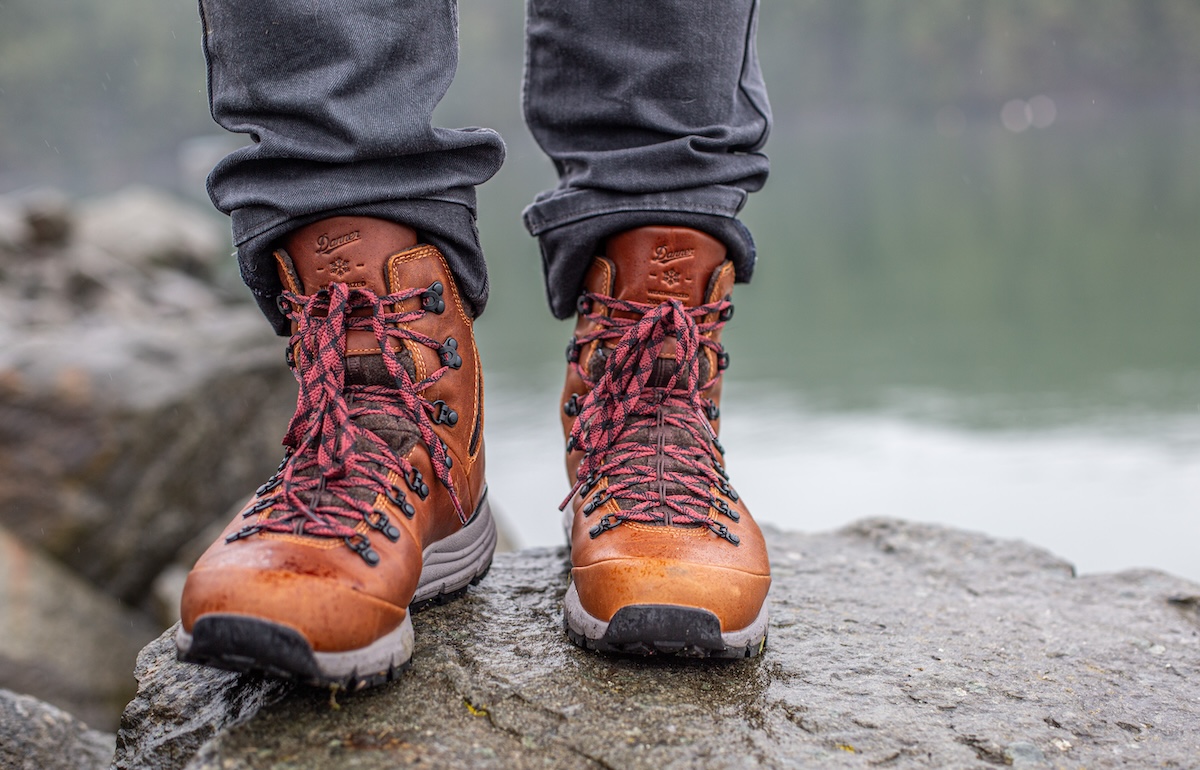
In general, winter boots put a premium on warmth and protection, which has a negative impact on breathability. Their substantial, waterproof constructions that do so well at trapping heat inside are equally prone to running hot in mild temperatures and during active use. For many folks, this is a fair trade-off, and breathability shouldn’t be a top consideration for those planning only quick trips outside or if conditions in your region are truly frigid. But if you live in an area with mild winters or plan to be hiking or snowshoeing for extended stretches, you’ll want a balanced design that has a lighter-weight upper and less insulation (around 200g). Hiking-ready models like the Oboz Bridger 7” Insulated and Danner Arctic 600 Side-Zip both perform well in this regard. If breathability is a top priority and temperatures will be warm (around freezing or above), it may be worth opting for a pair of uninsulated hiking boots instead.
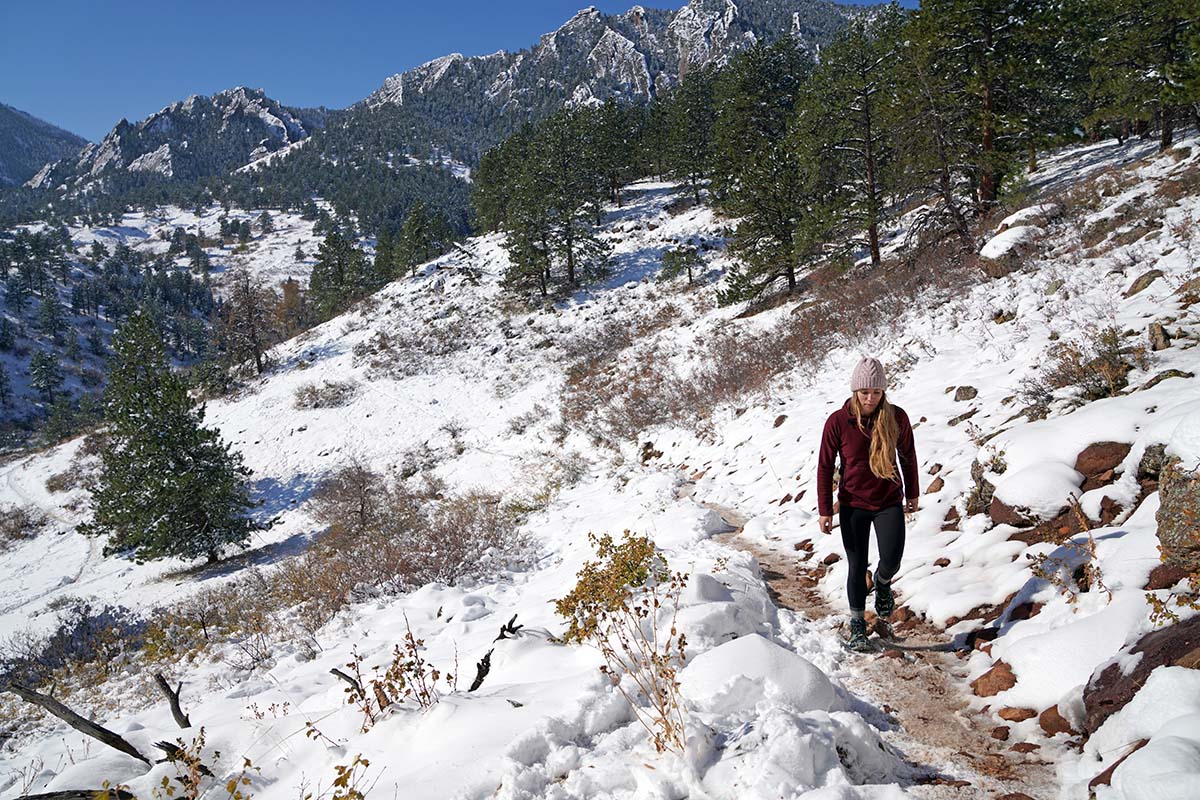
Snow boots have a different lug pattern and rubber compound than their on-dirt hiking boot cousins. The compounds are softer and don’t harden even when temperatures drop, which helps them to grip on snow and ice. In addition, the lug patterns are aimed at preventing snow buildup. The outer soles themselves are very thick and absorb energy well to isolate your feet from any jarring impacts while walking. Vibram made some headlines with their Arctic Grip compound that's specifically designed to stick to slippery and icy surfaces, which we see in designs like the Danner Arctic 600 Side-Zip and Muck Boot Arctic Sport. In general, hiking-ready models have the best traction, while casual and work boots can be a little cumbersome and prone to slippage. Regardless of the boot, in very icy conditions we’ll still turn to a winter traction system (covered below).
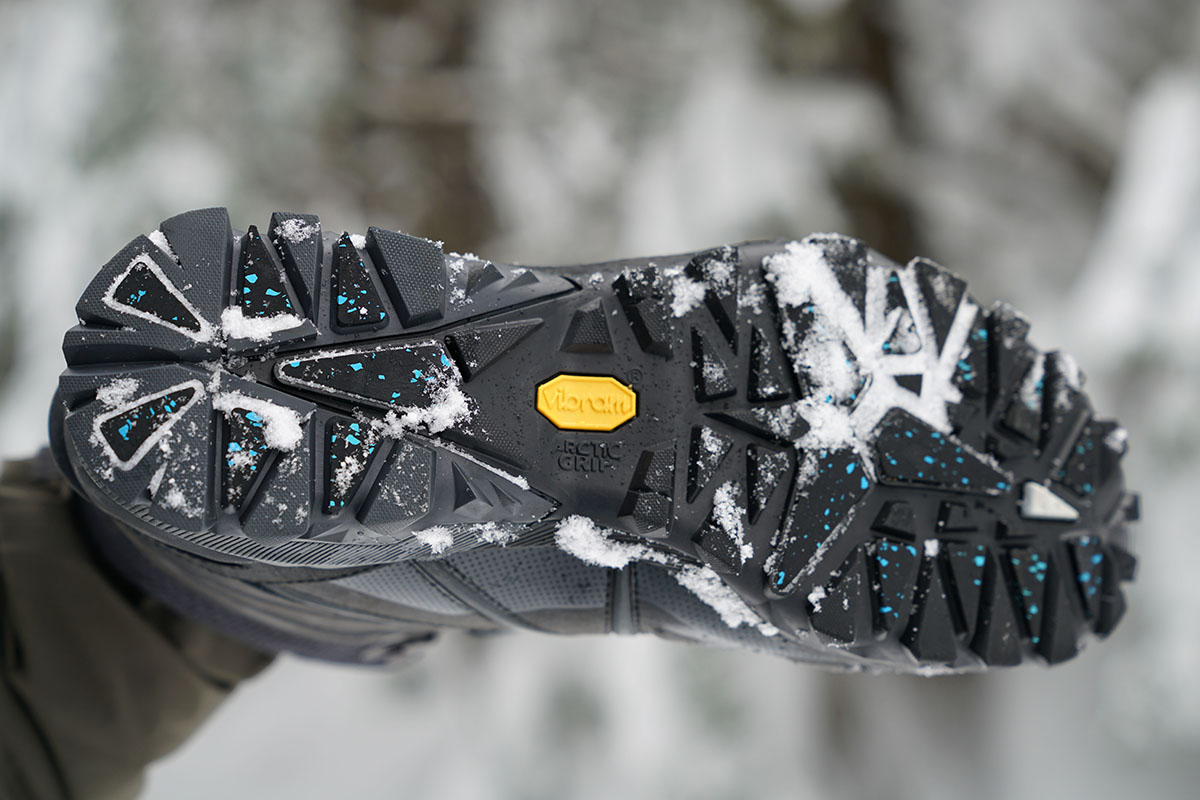
Pairing your winter boots with quality socks helps to maximize warmth and comfort. It’s true that you can get away with just about any design for quick trips outside, but if you’ll be hiking, working, or spending significant stretches of time in harsh weather, it’s worth dialing in your sock selection. Material-wise, the clear leader is wool—and particularly the merino variety—for its high level of warmth, breathability, and stink prevention. Synthetics are a viable alternative, but they’re usually not as warm and will retain smells more than wool. Avoid cotton socks at all costs—they don’t wick away moisture or insulate when wet, which is a bad combination for winter use.
In addition to choosing the right materials, you also need to think through the thickness of your socks. For the most part, the best socks for winter use fall in the mid- and heavyweight categories. Both are fairly thick, which means you’ll likely need to size your boots accordingly (more on this in the fit section below). For everyday use or if you’re not prone to running cold, a midweight sock is a versatile choice. In this category, we love Darn Tough’s Hiker Boot Full Cushion, which provides decent warmth to complement your boots but won’t overheat as easily in mild temperatures or when working hard. Heavyweight options like Smartwool’s Classic Mountaineer are a whole different breed—they’re thick enough to nearly double as a pair of slippers and provide a noticeable bump in insulation and cushioning underfoot. For sub-zero temperatures or if you’ll be sedentary outside, it’s worth going with a super thick design.
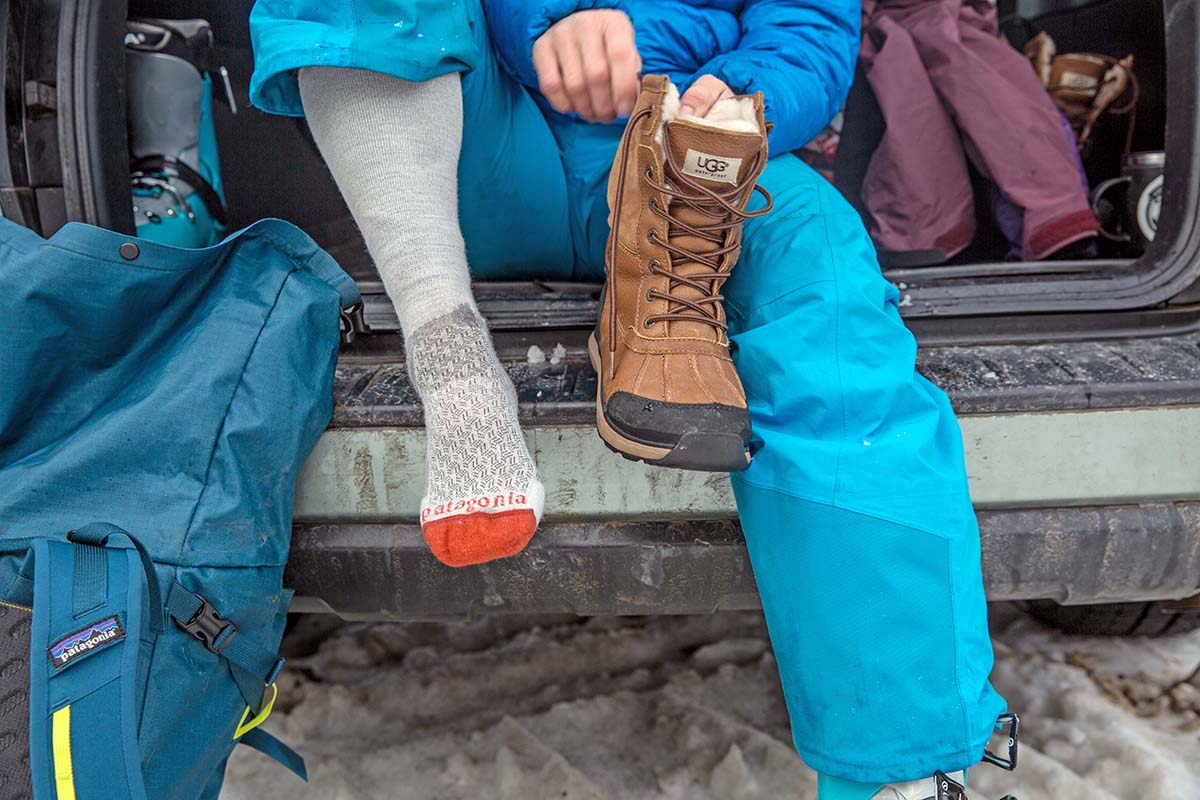
Fit is always an important consideration with footwear, and the same holds true for winter boots. A properly sized boot should be large enough to accommodate your thickest socks without pinching (a fit that is too snug will inhibit circulation and compromise the warmth the boot provides). It’s also important to consider the type of activity: a boot that will only be worn around town, like the Sorel Caribou, doesn’t have to fit perfectly to perform well (you can err on the side of going a little loose). But for the more hiking-focused models like the Merrell Thermo Chill, it’s best to get fit dialed in. If you have wide feet and prefer more room for your toes to splay (or for thicker socks), a "barefoot" style design like the Xero Alpine Snow Boot might be a good choice.
Sizing varies widely between brands and individual models, and we provide as many insights as possible in our product write-ups above. In general, be prepared to order a different size than what you normally would for a pair of hiking or trail running shoes. If there aren’t specific recommendations from the manufacturer or you can’t piece together a good idea on fit from reading user reviews, we’ve found the following works pretty well: If you’ll be wearing midweight socks, it’s a good idea to go up a half size. Expedition-level socks are extremely thick, so it’s common to go up a full size in these cases. Again, fit can be tough, and it’s always best to try them on if you can before buying. But if you’re shopping online, do your research and be prepared to size up in many cases.
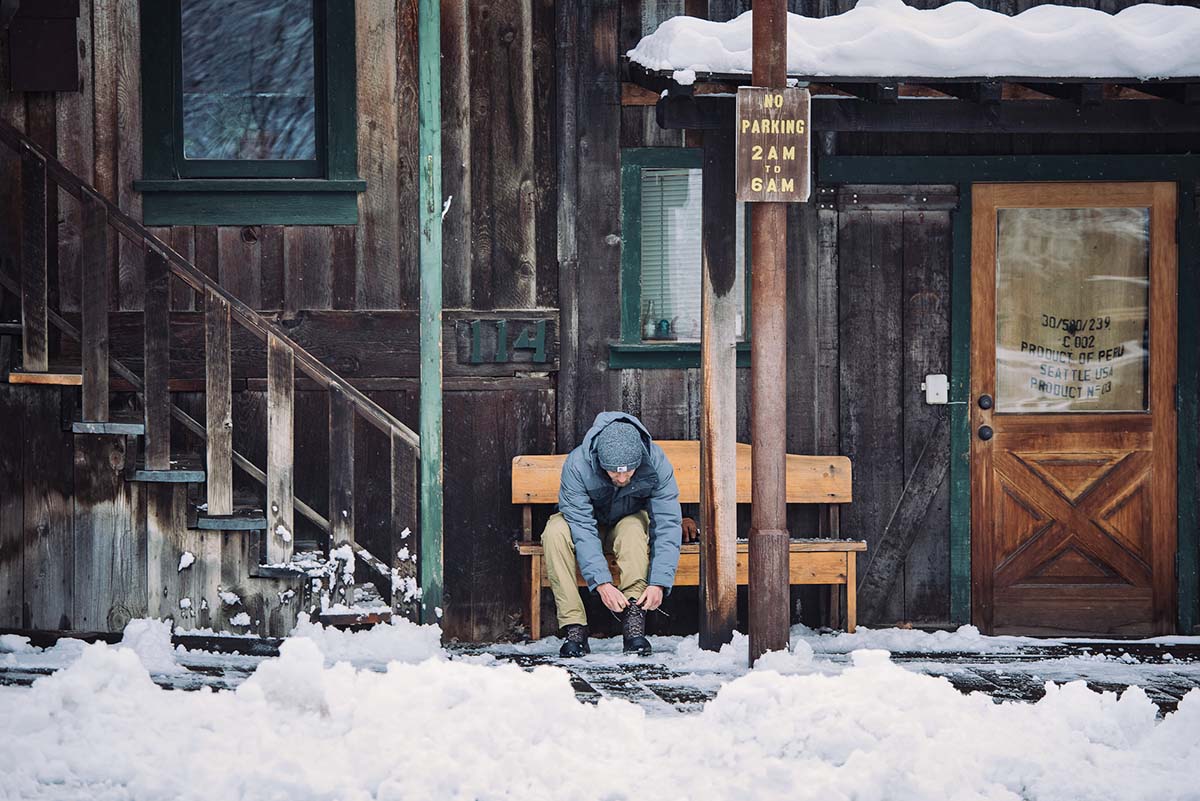
To keep your winter boots lasting as long as possible, it’s worth taking proper care of your investment. For starters, it’s always a good idea to keep them clean to avoid any breakdown in the materials. The grime that you pick up when walking through a slushy parking lot can wreak havoc on a boot if it isn’t cleaned off. Warm water, dish soap, and a simple brush can do the trick in most cases. Further, many of the designs above have leather in the construction, which is a material that benefits from occasional treatment to avoid drying and cracking. A quality sponge-on design like Nikwax’s Conditioner works well on full-grain leather, keeping it in good shape while adding a water-resistant coating to the top. For boots that don’t have a waterproof membrane or coating, you’ll want to treat them from the start. Another benefit of adding a leather dressing right away is that it helps soften the leather and shorten the break-in period.
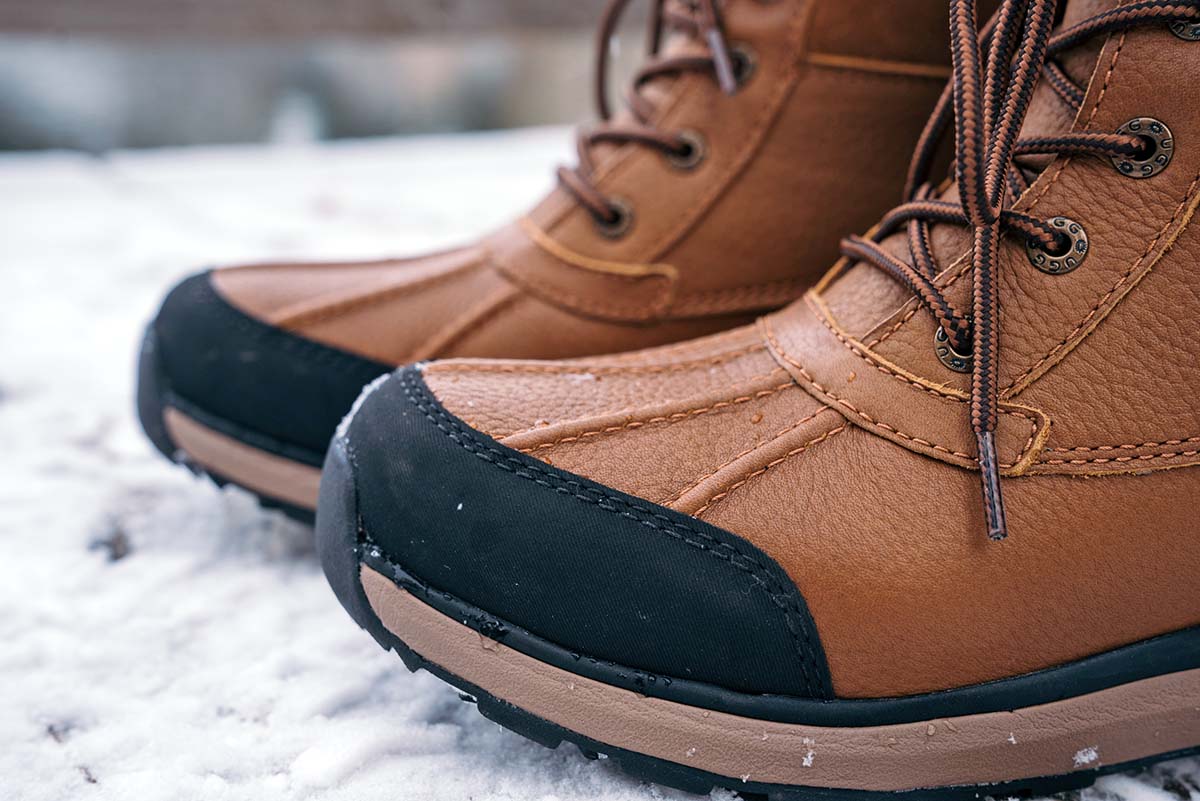
Winter boots have outsoles designed for walking on snow, but the reality is that even the best rubber compound and tread pattern won’t grip all that well on a sheet of ice. To safely hike or even walk around town if the conditions are really bad, we use an additional traction system (also referred to as a traction device). There are a variety of designs on the market, from chain-style Yaktrax for casual walking to the Kahtoola Microspikes for heavy-duty ice and backcountry use.
For pairing with winter boots, one of our favorite traction systems is the Yaktrax Diamond Grip, which is reasonably priced at $55 and realistically all you’ll need for everyday use. Rather than more traditional spikes underfoot, the Diamond Grip boasts steel alloy “beads” strung across steel cables, which we’ve found to be reliable for everything from shoveling and commuting to snow-blowing steep driveways and even light winter hikes. For a step up in performance, Kahtoola’s Microspikes provide a notable boost in traction but are overbuilt for around-town wear. The downside with all traction systems is that they take a little time to put on and take off, and can be overkill for mixed conditions, but they’re the best way to cover ground safely on icy days. For a full breakdown of options, see our article on the best winter traction devices.
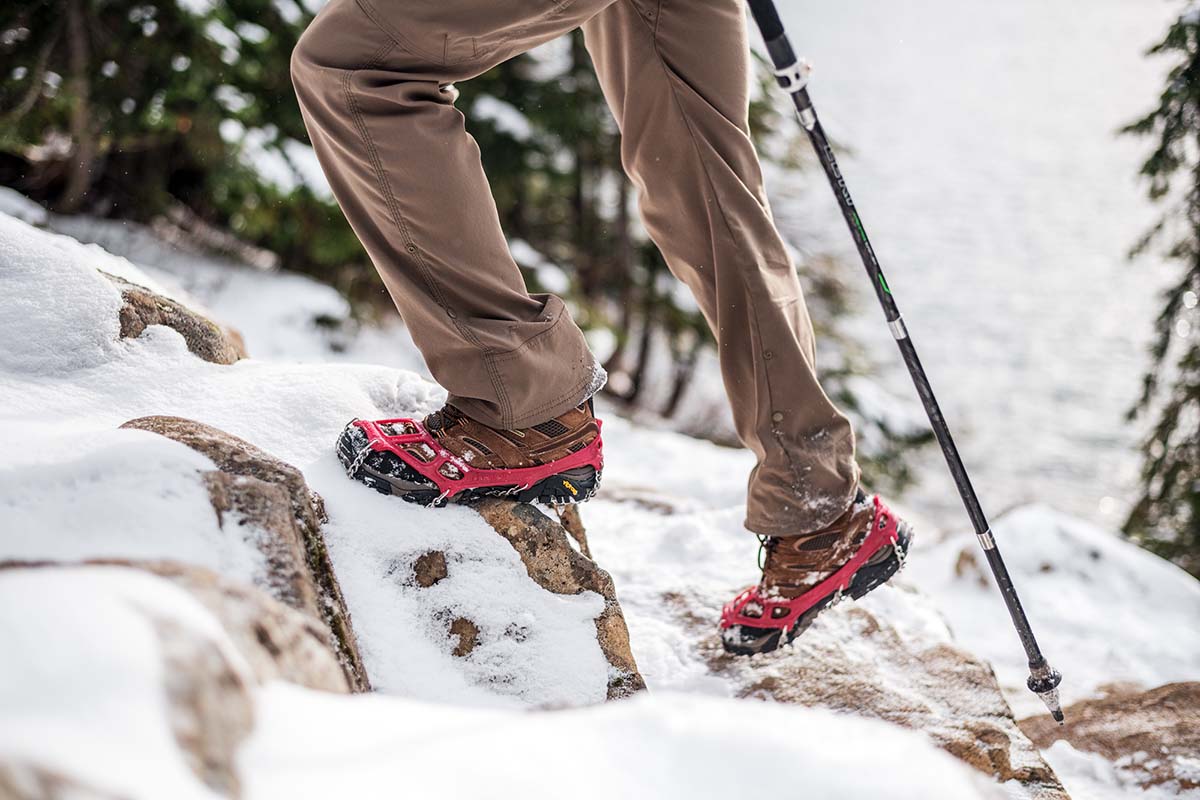
Dedicated winter boots offer premium protection and warmth in freezing, snowy conditions, but we often use our regular hiking boots for short and active winter jaunts. For example, if you will be snowshoeing or walking without stopping, uninsulated and waterproof hiking boots with good socks may very well do the trick. One of our favorite models from above is the Merrell Thermo Chill 2 Mid, which has a durable, water-shedding exterior and insulation that offers lightweight warmth. To be clear, this is a good option for trips when you will be on the go the whole time and the weather isn’t particularly frigid. If you’ll be stopping or out for long stretches of time, it’s safest to look to something burlier or with a higher level of insulation.
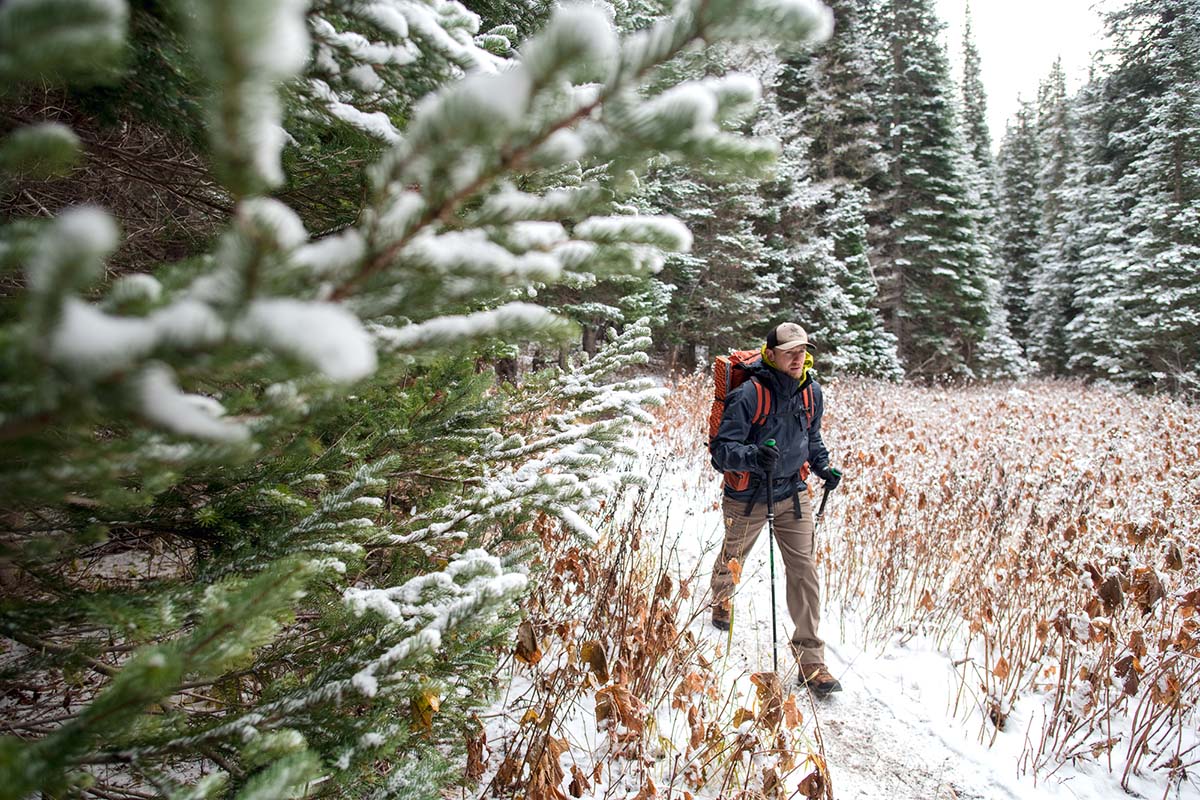
Our picks above were selected based on the experiences of both male and female testers, and you’ll notice that we link to both the men’s and women’s versions whenever possible. That said, due to noteworthy variations in style within this category, we’ve also put together a separate round-up of the best women’s winter boots. Curated by our female editors, you’ll find many of the same models here (names and colorways often differ) in addition to a number of other women's-specific options for casual use, outdoor work, and winter hiking.
Back to Our Top Winter Boot Picks Back to Our Winter Boot Comparison Tables